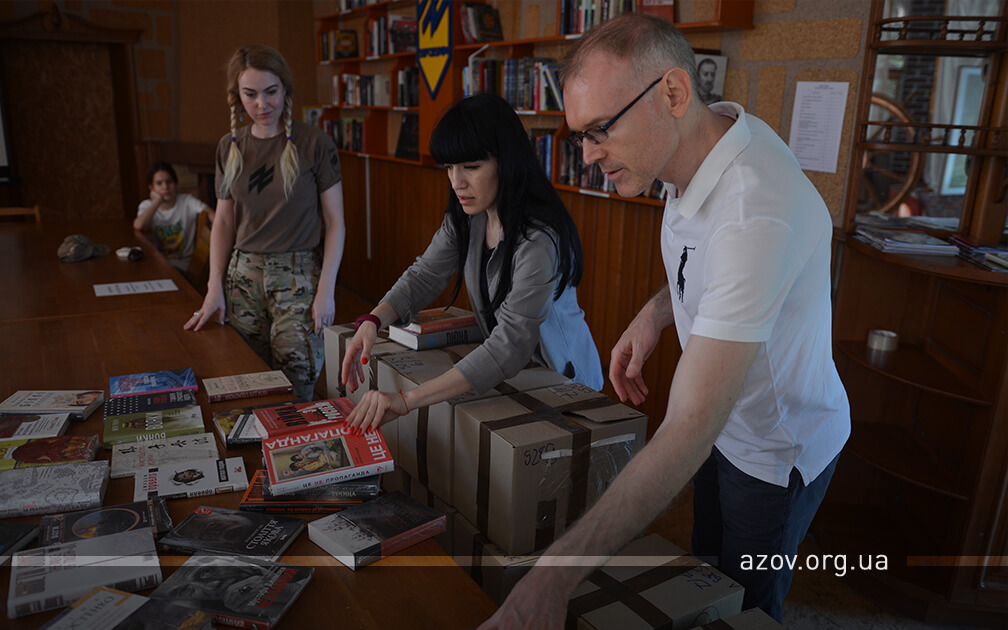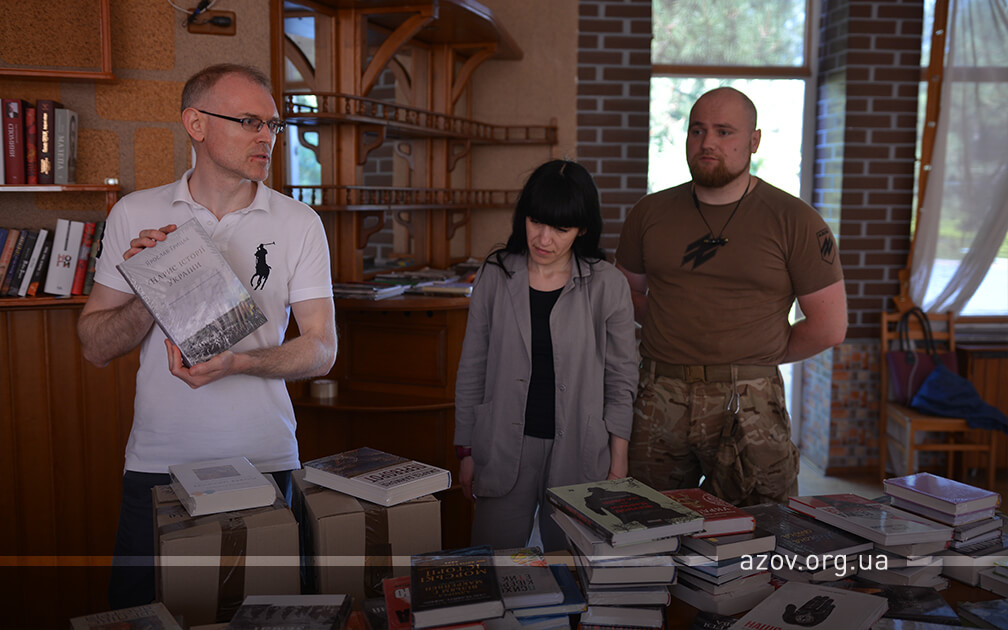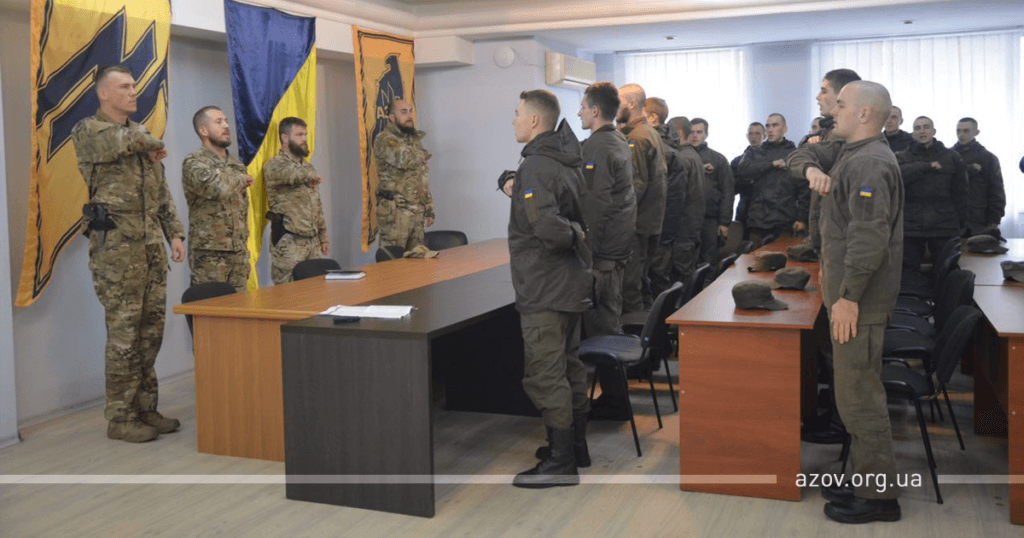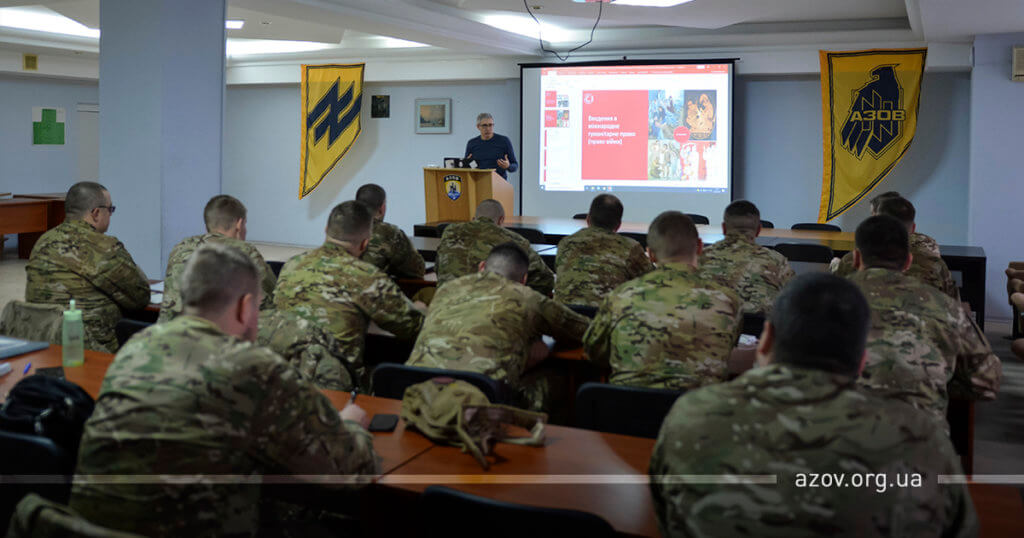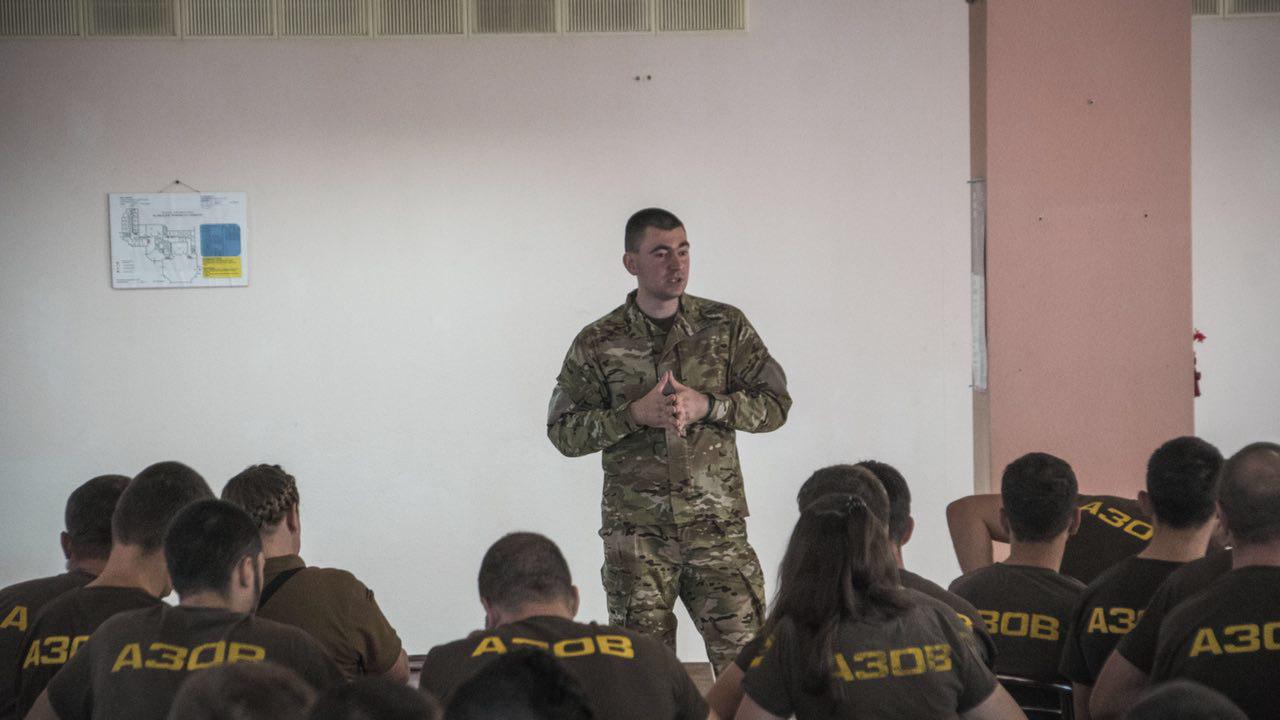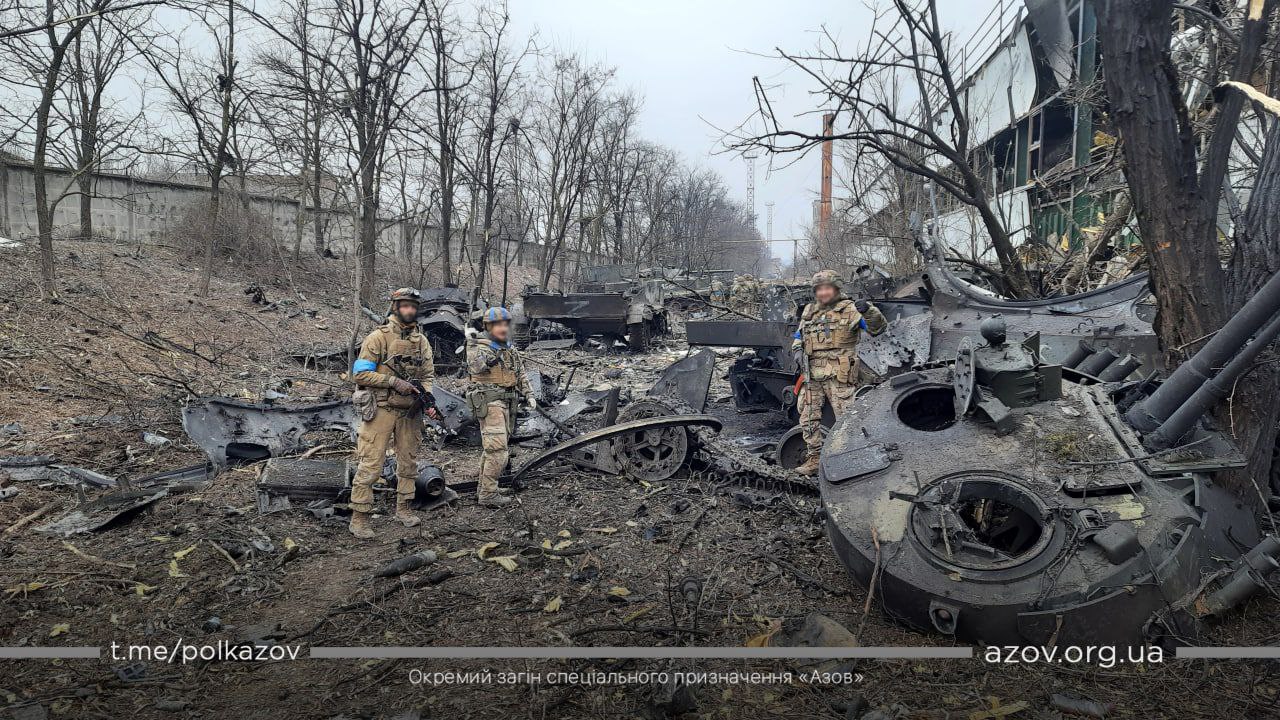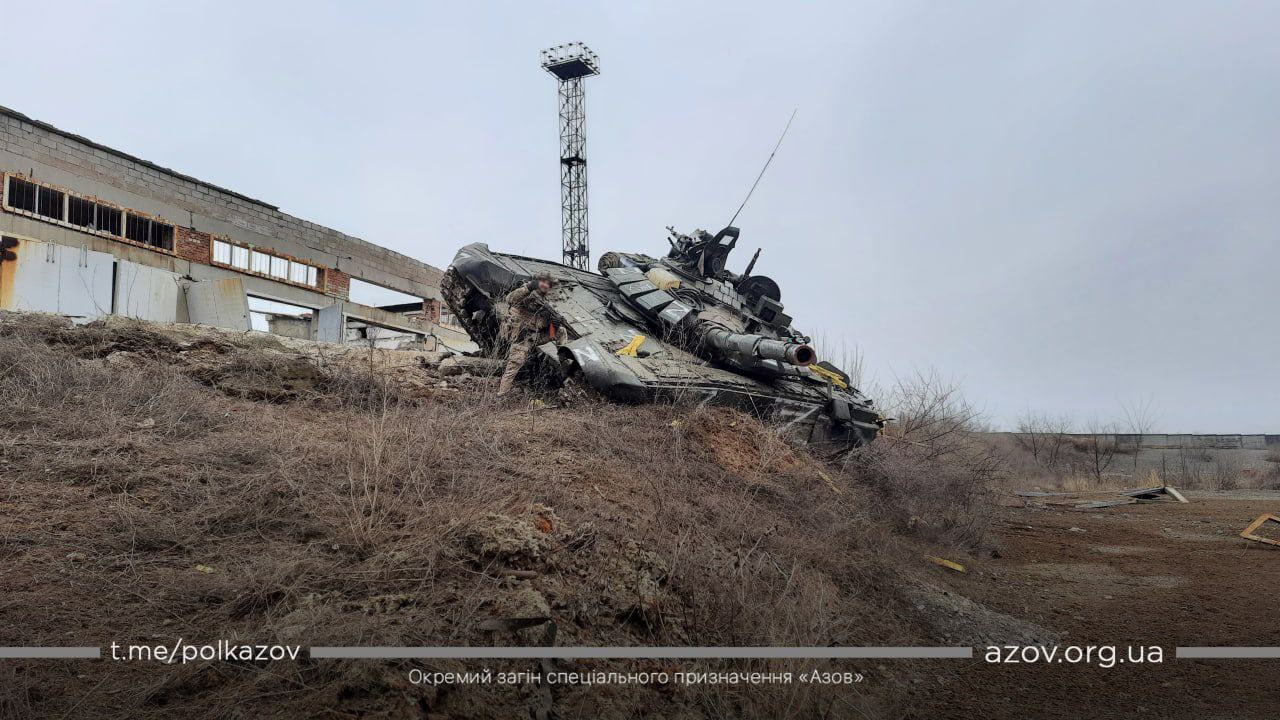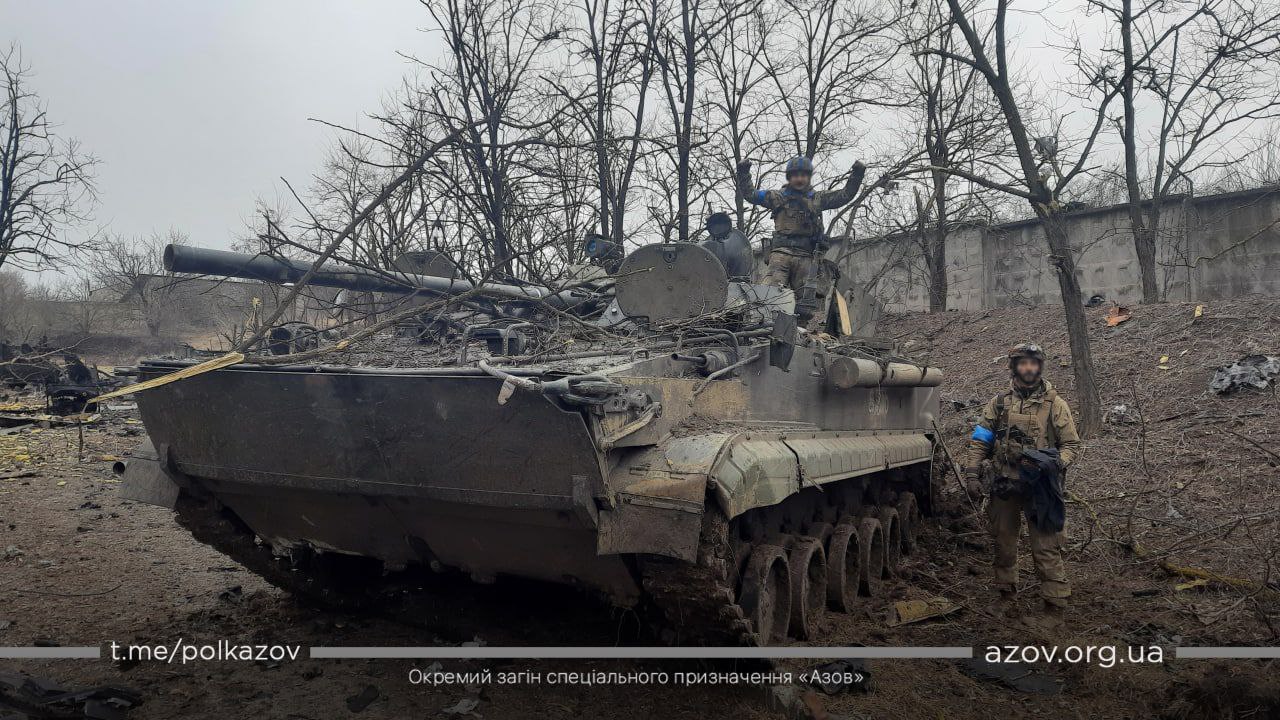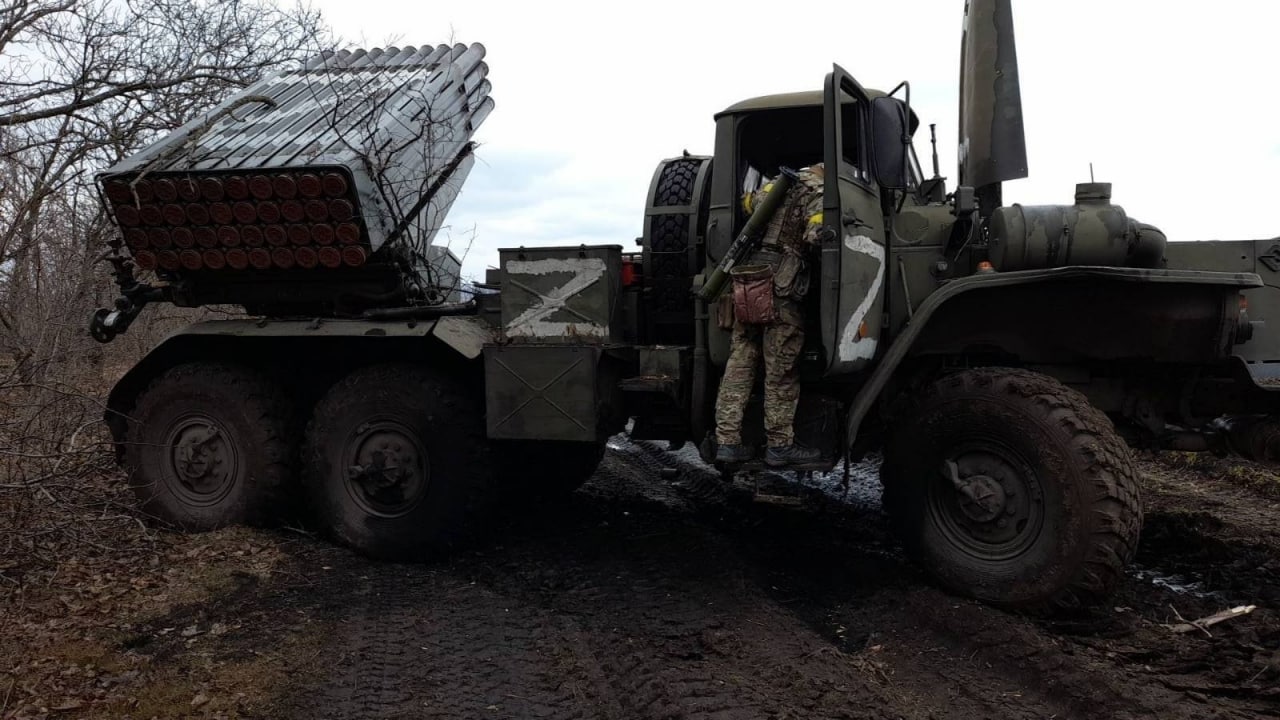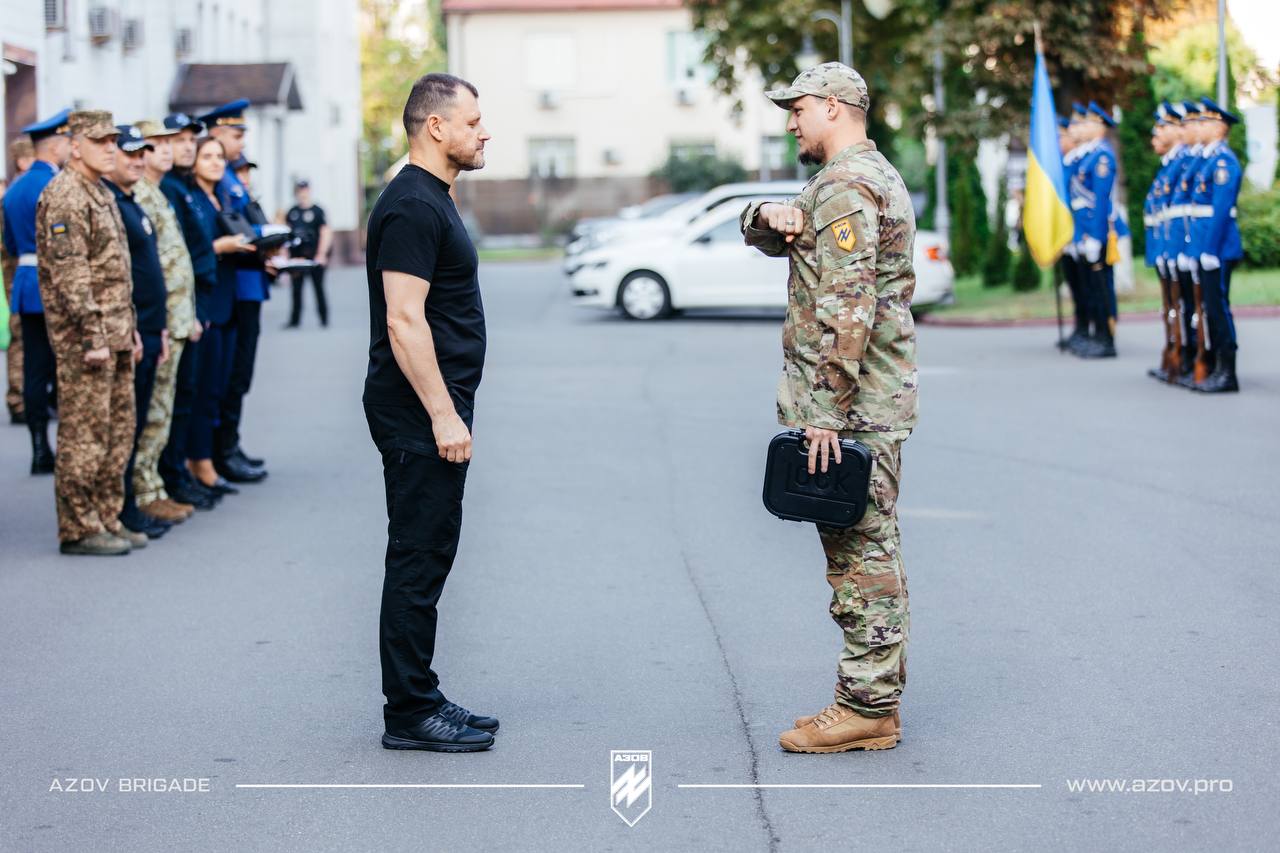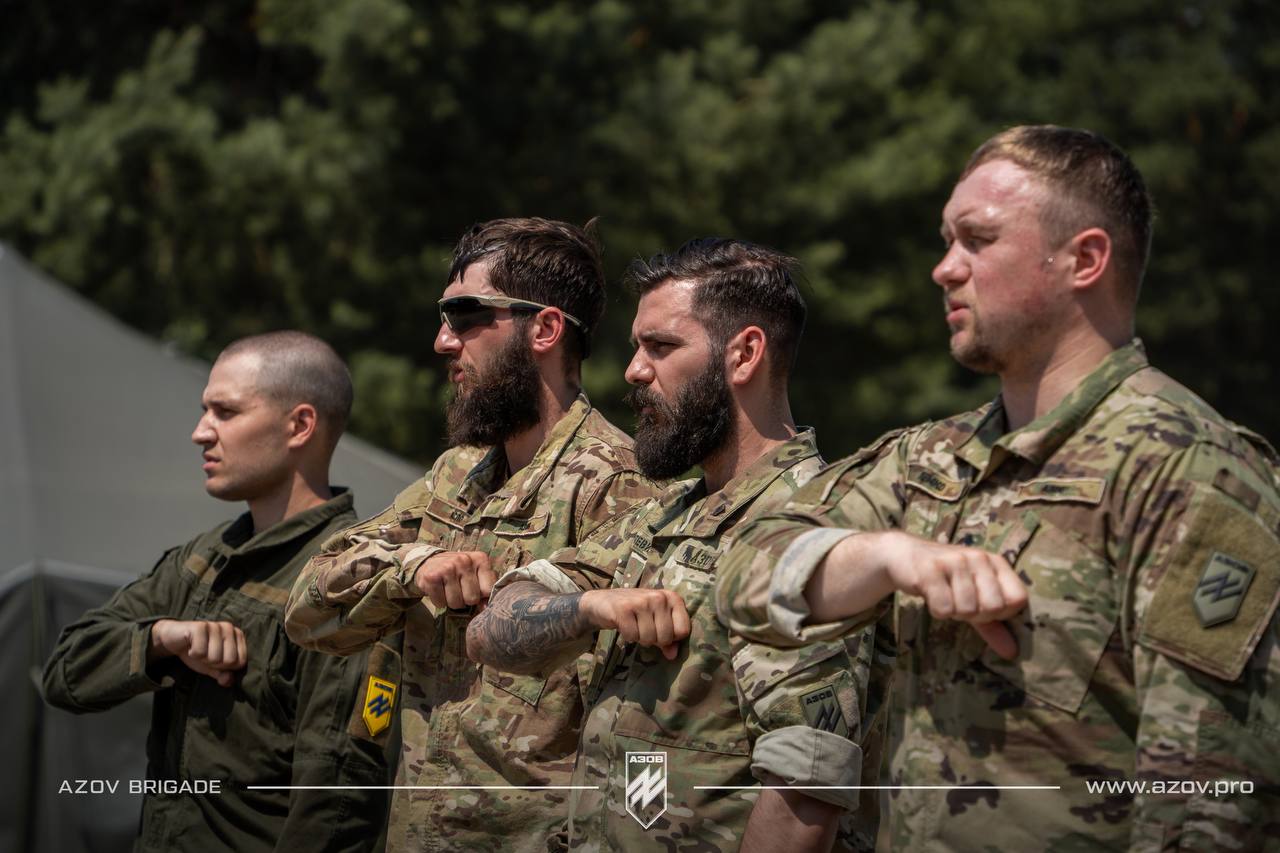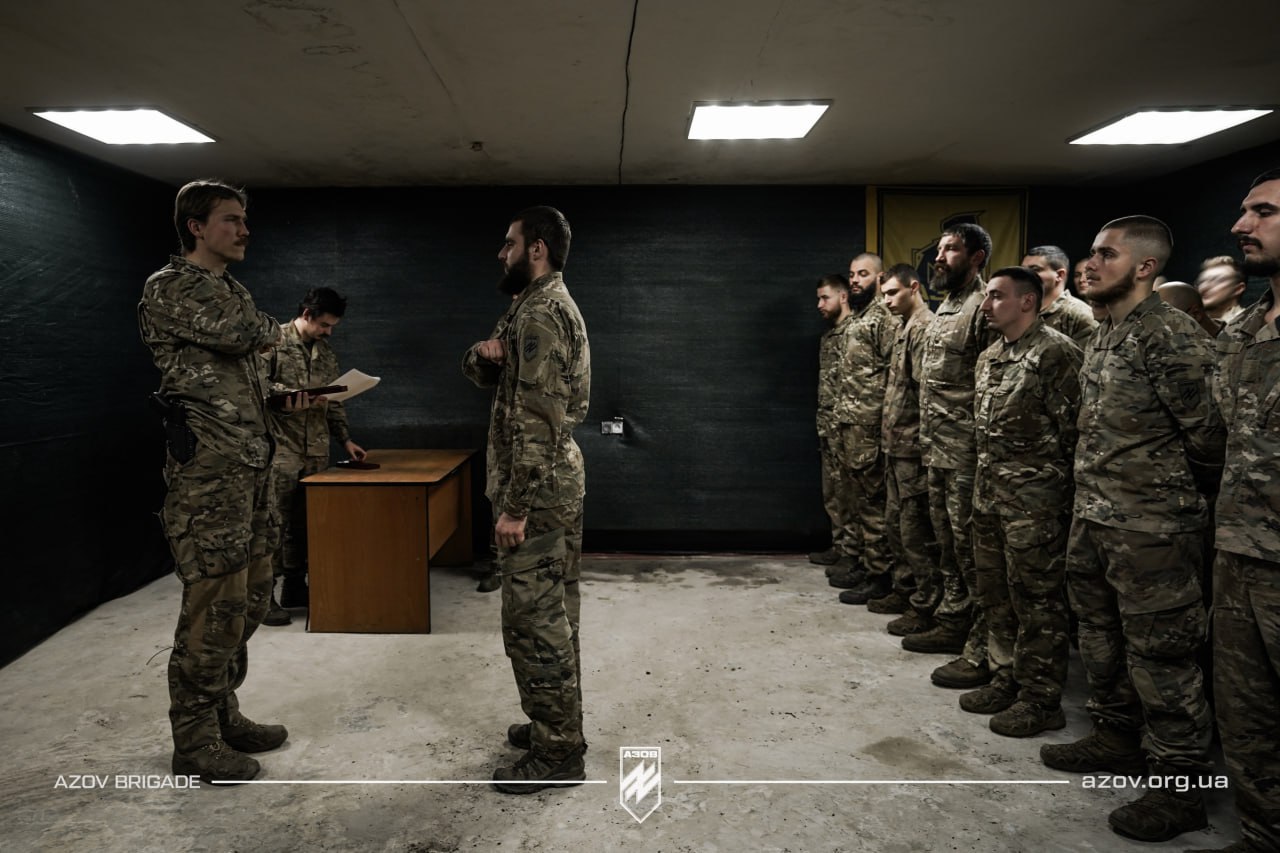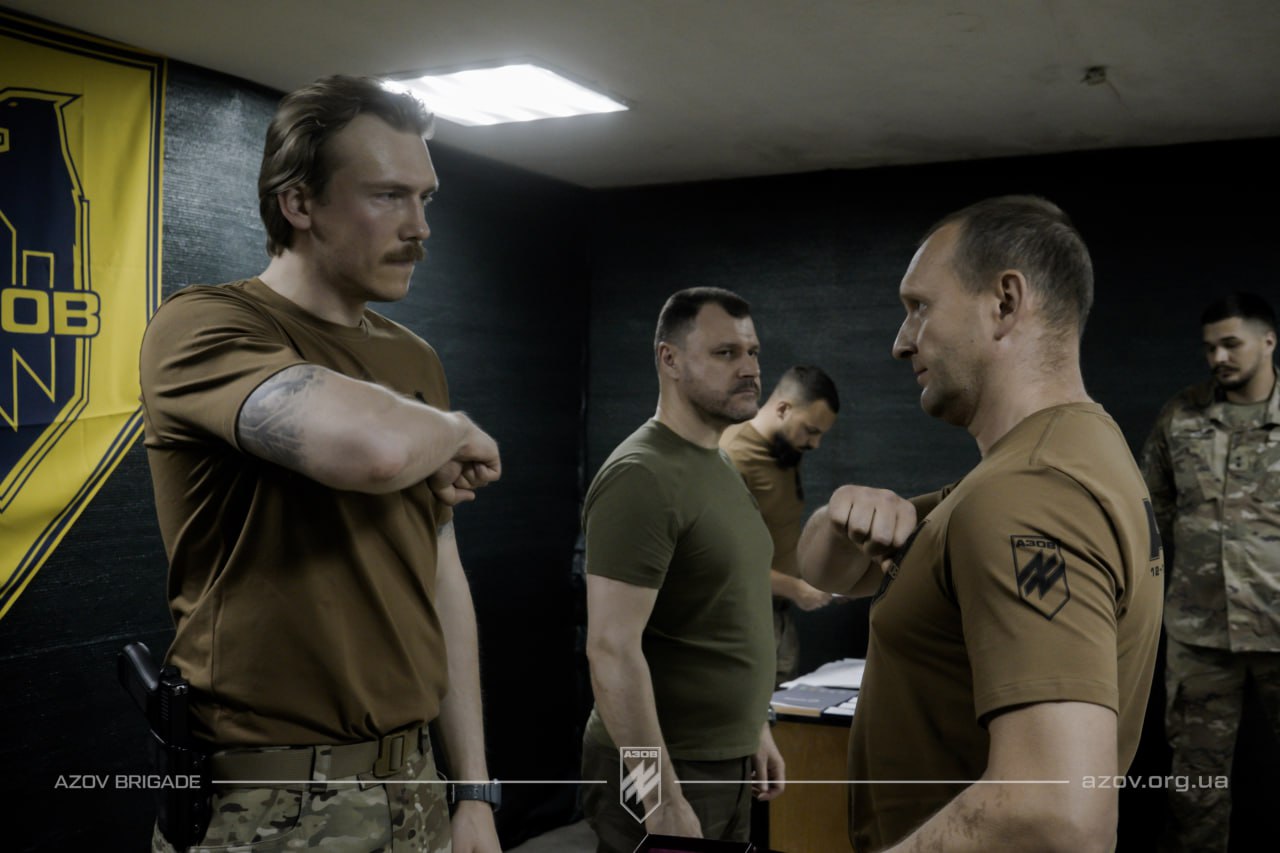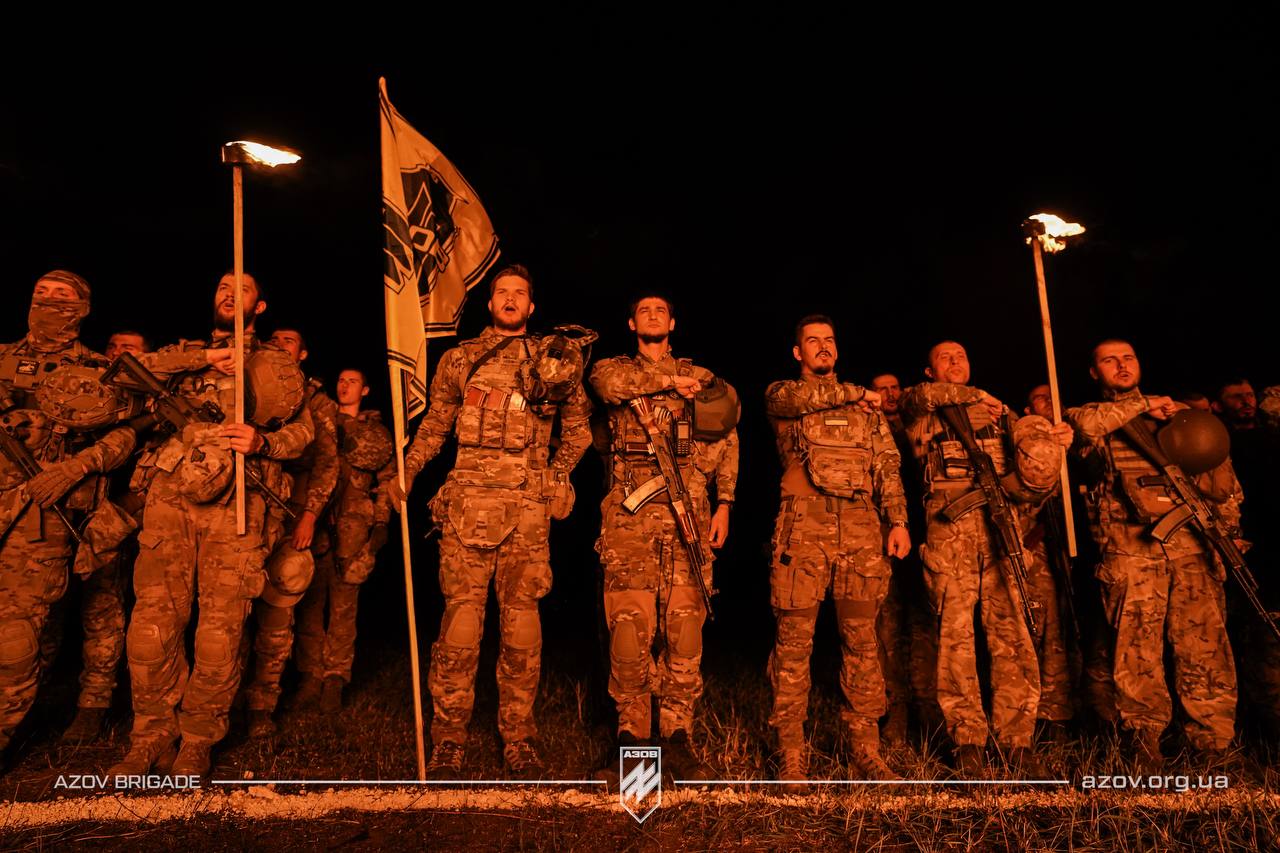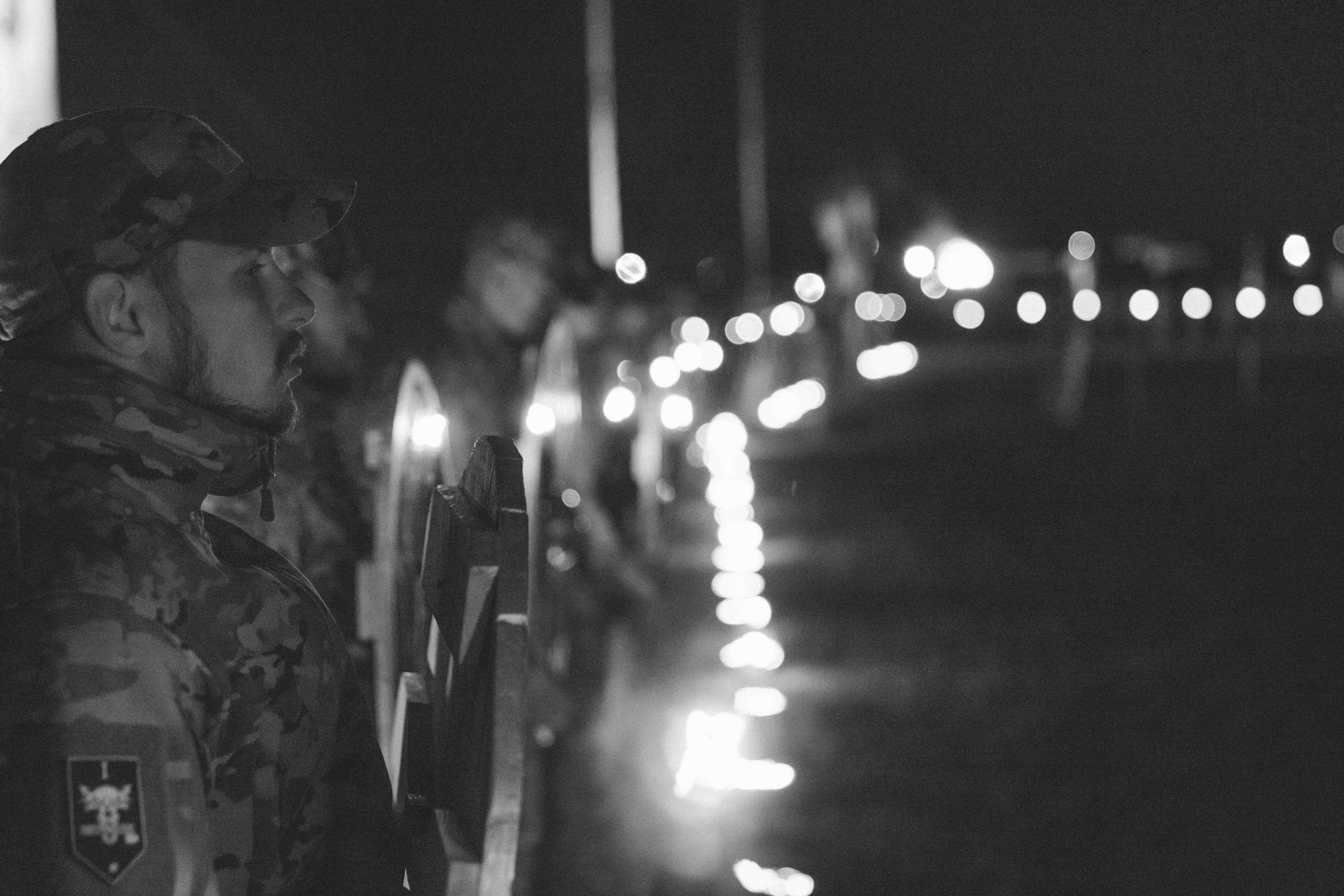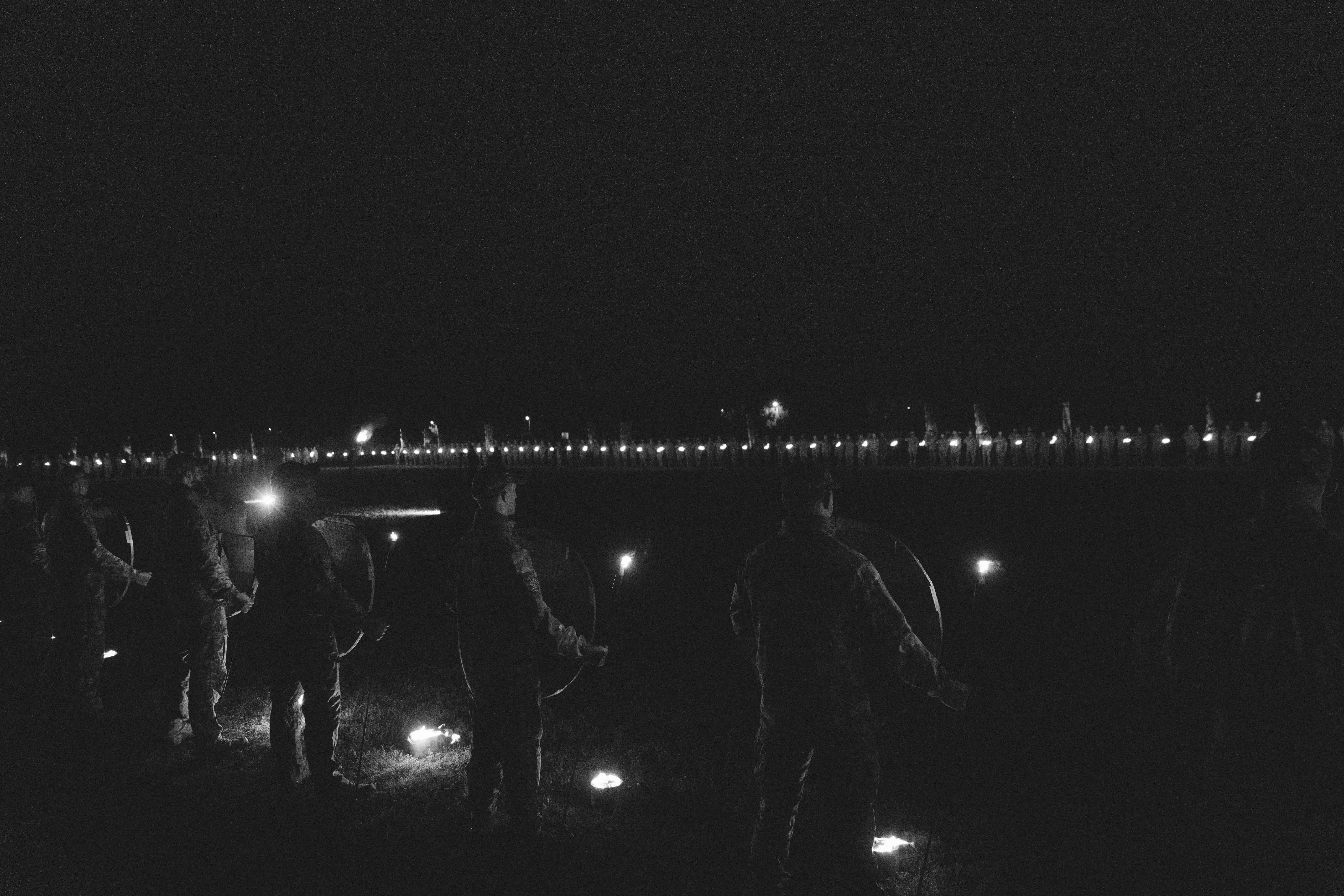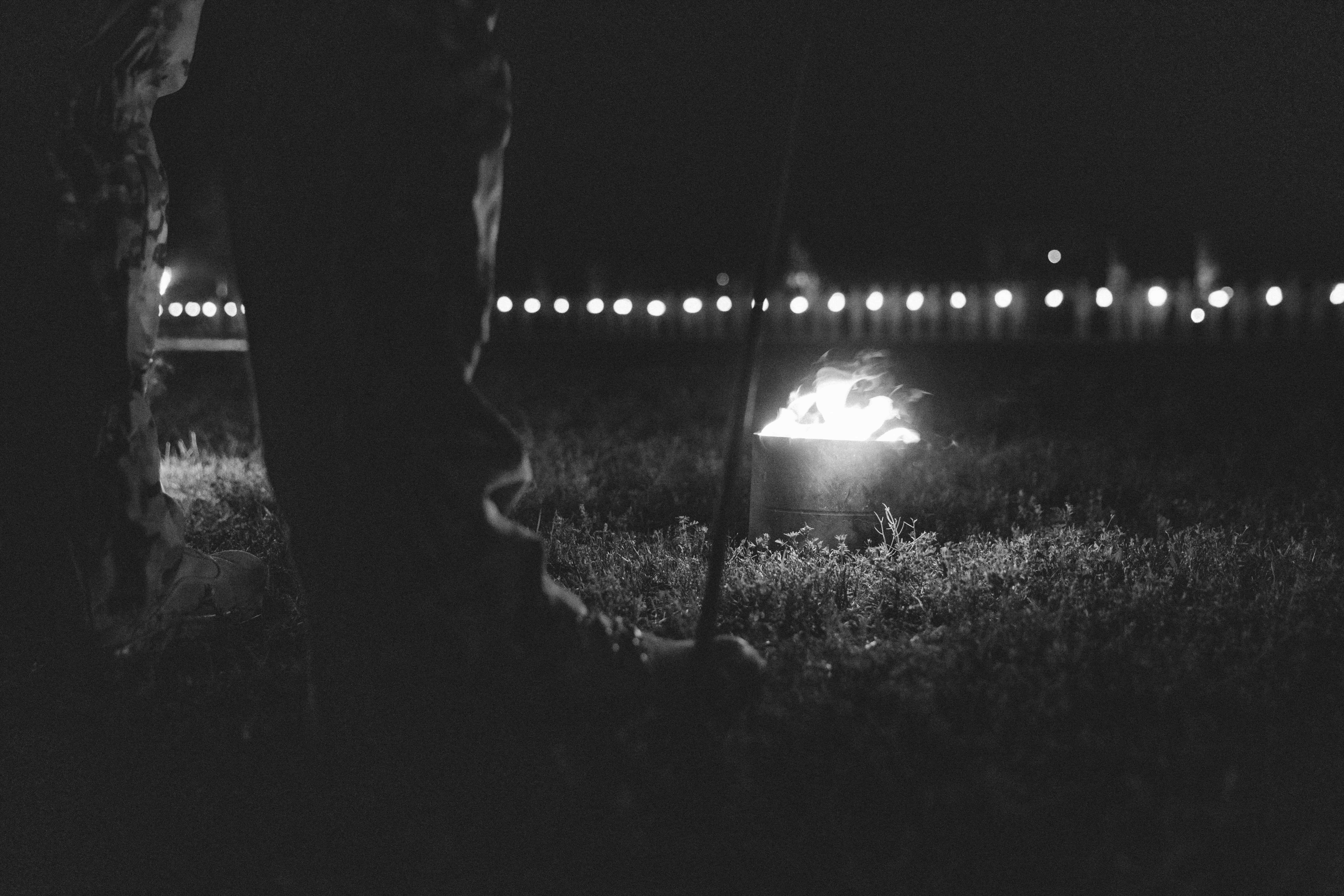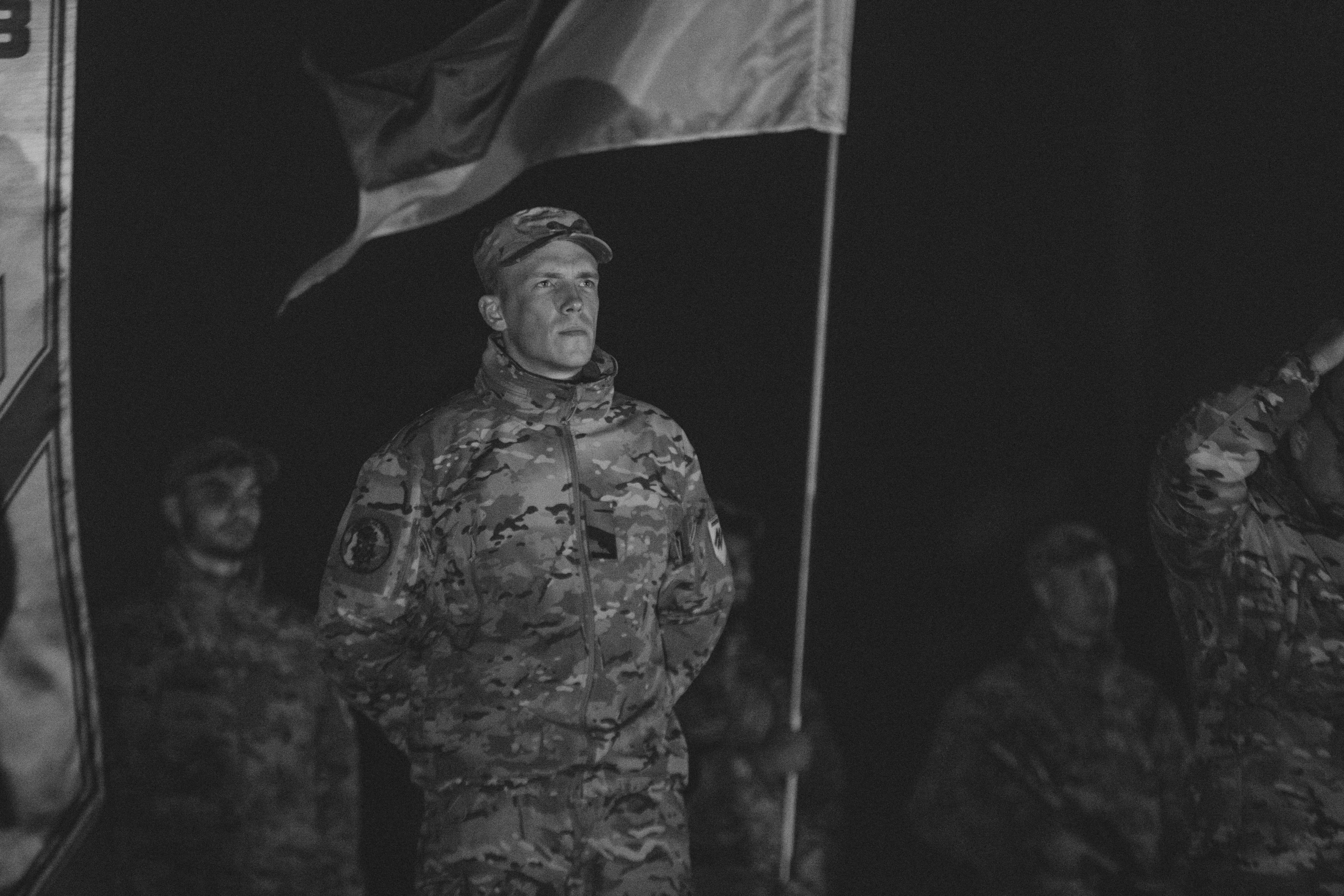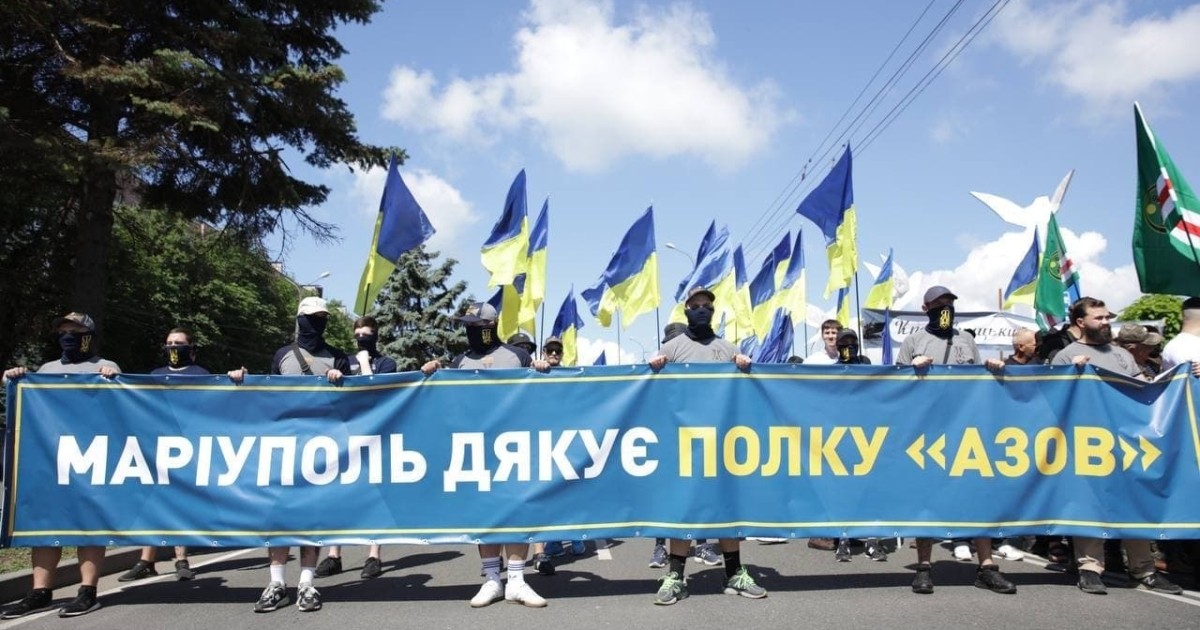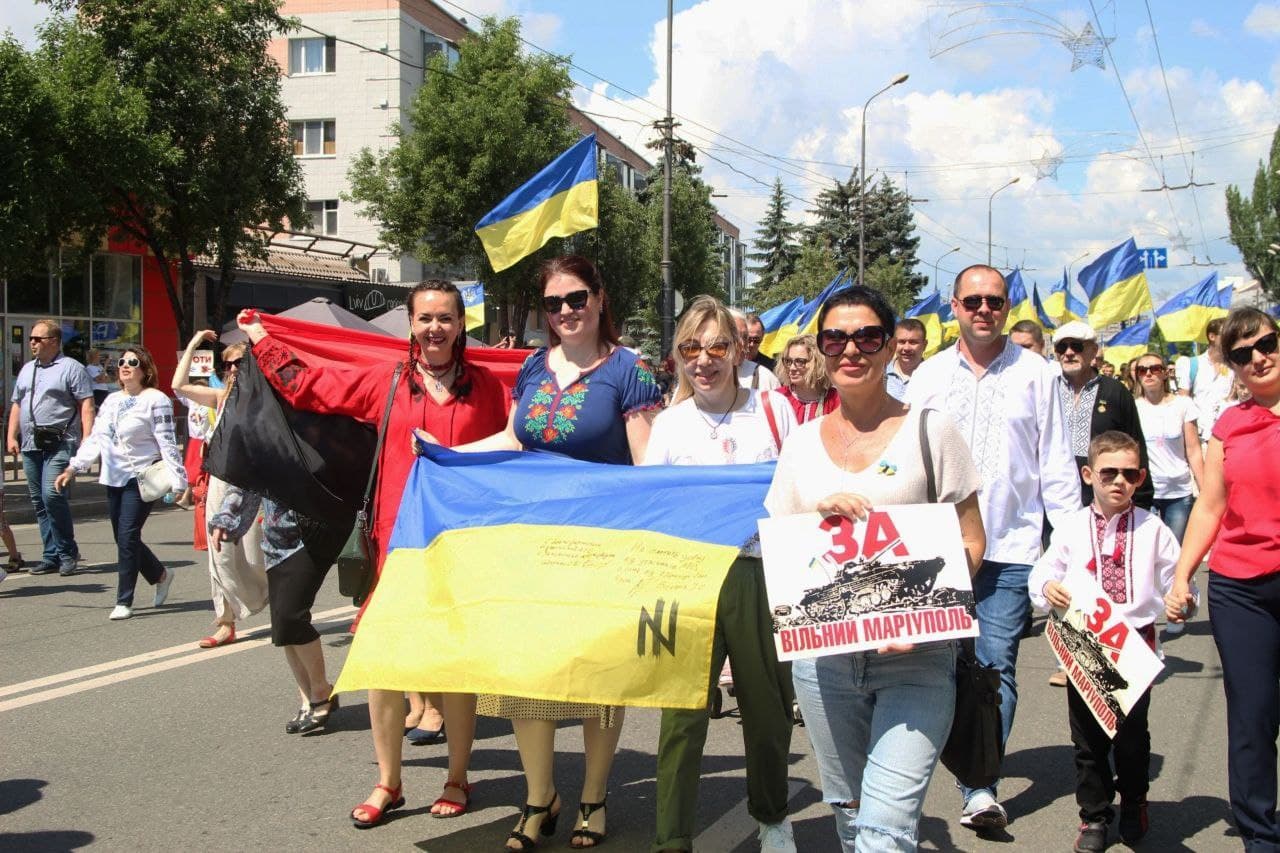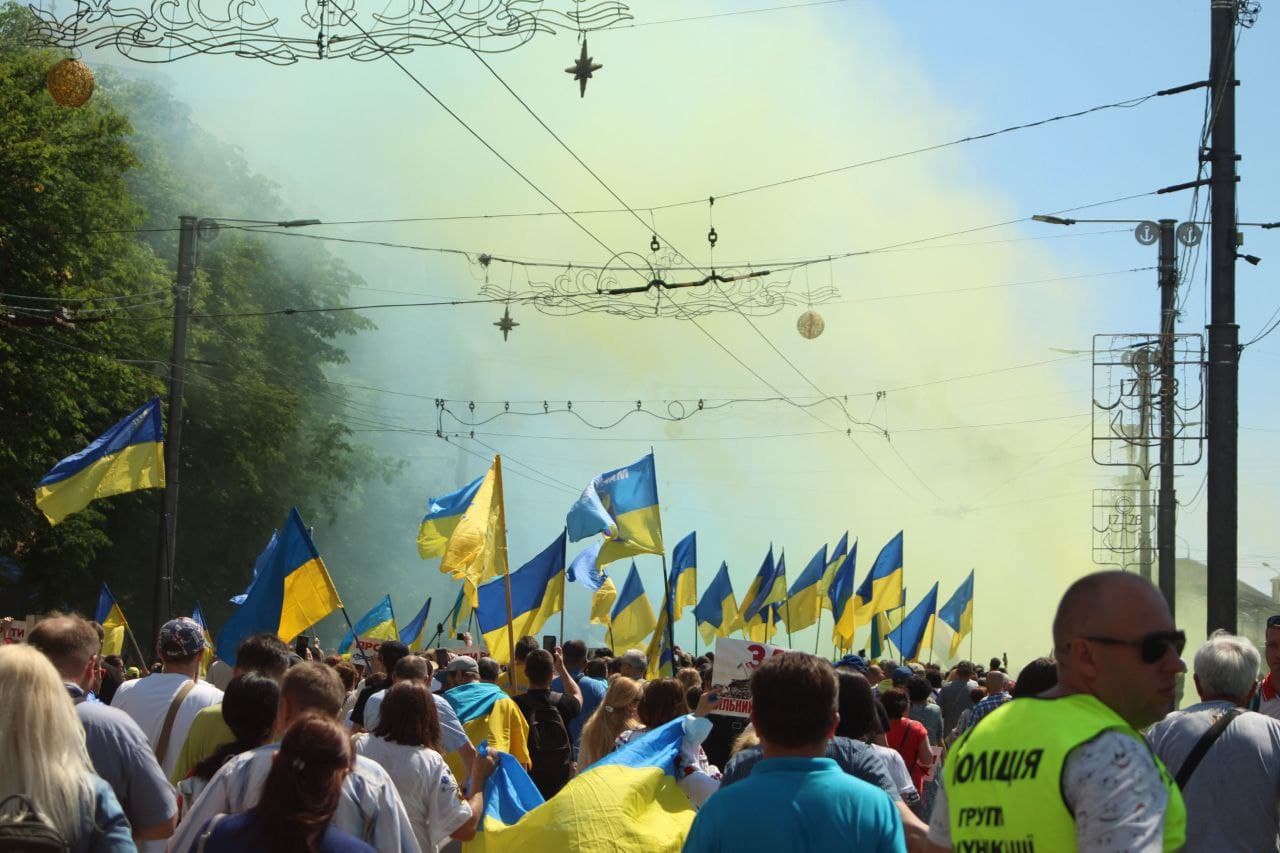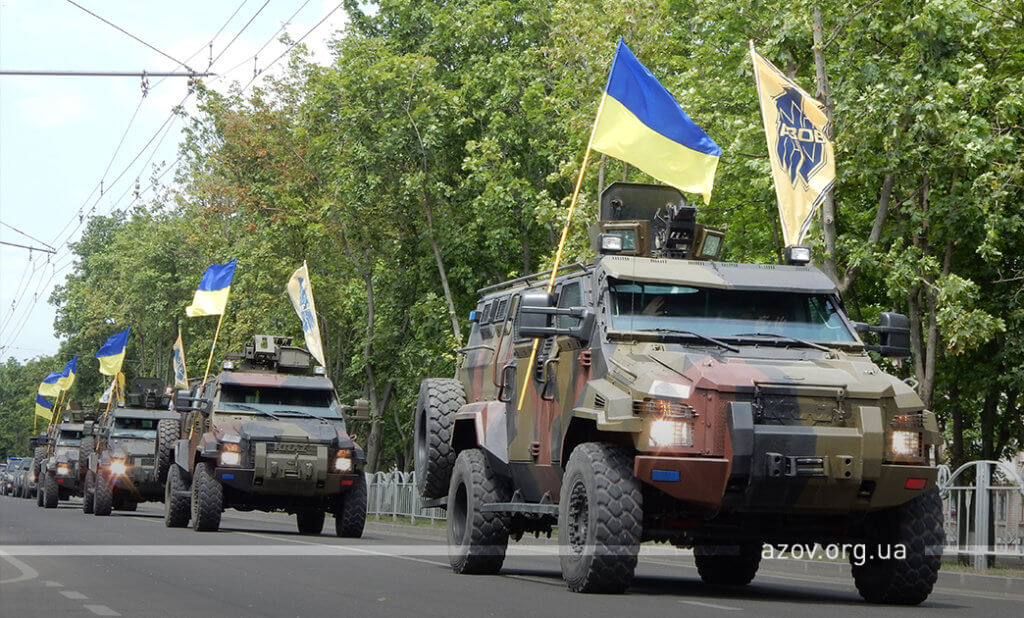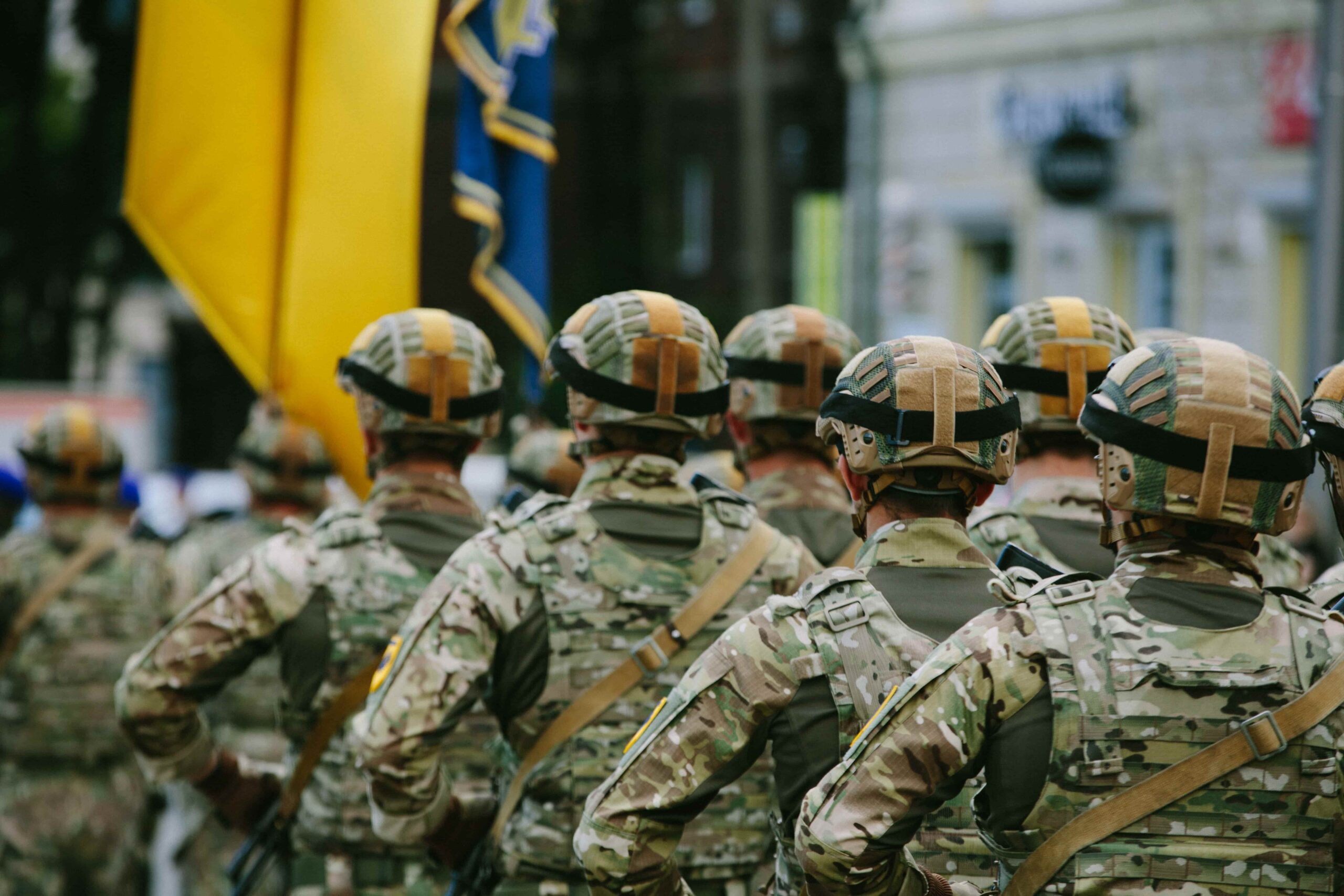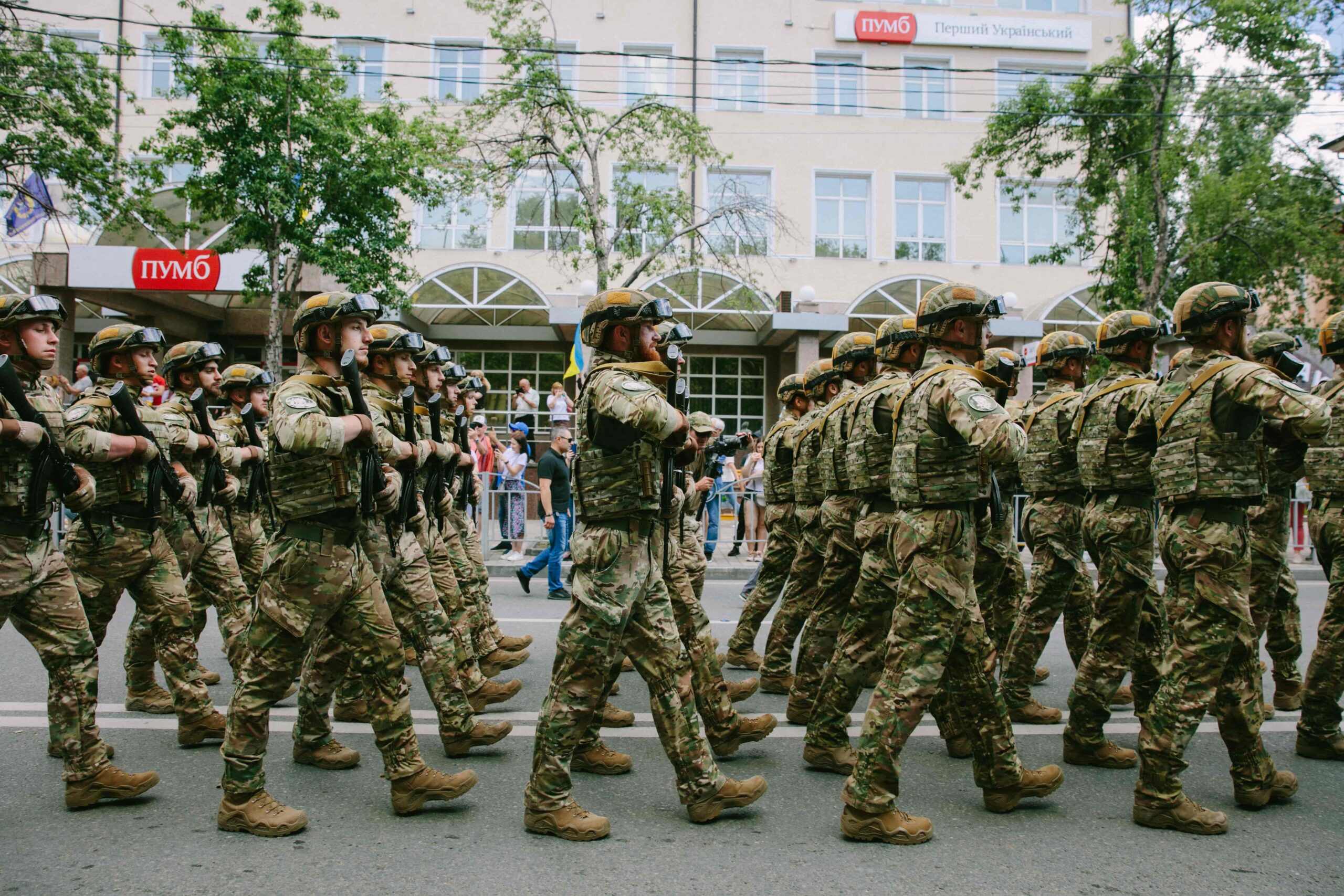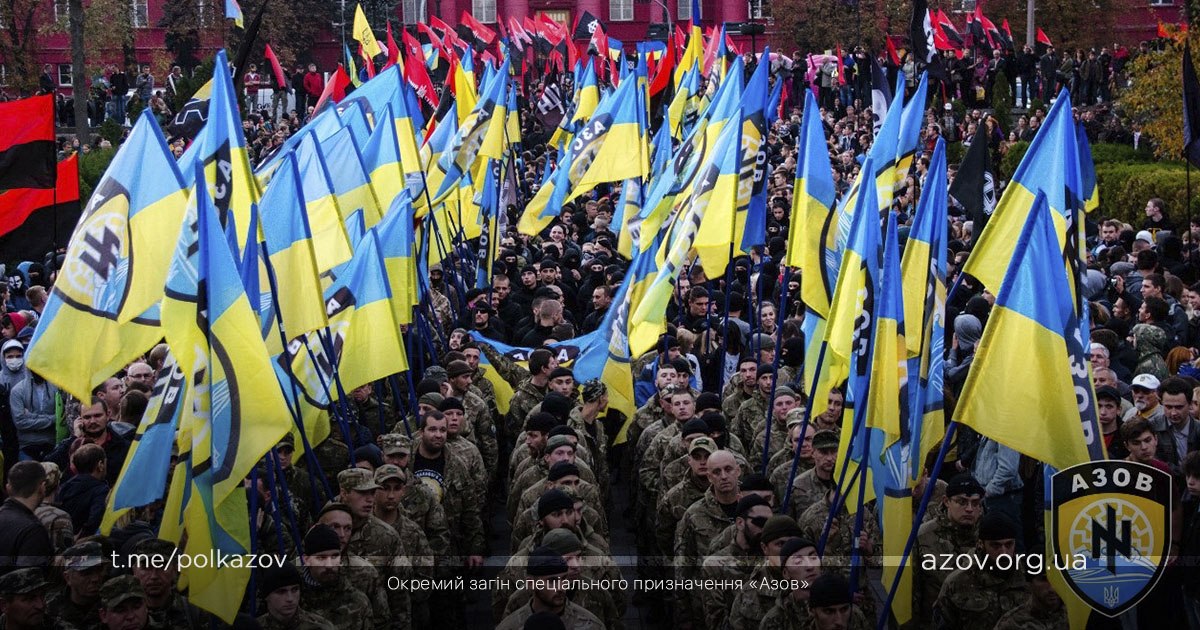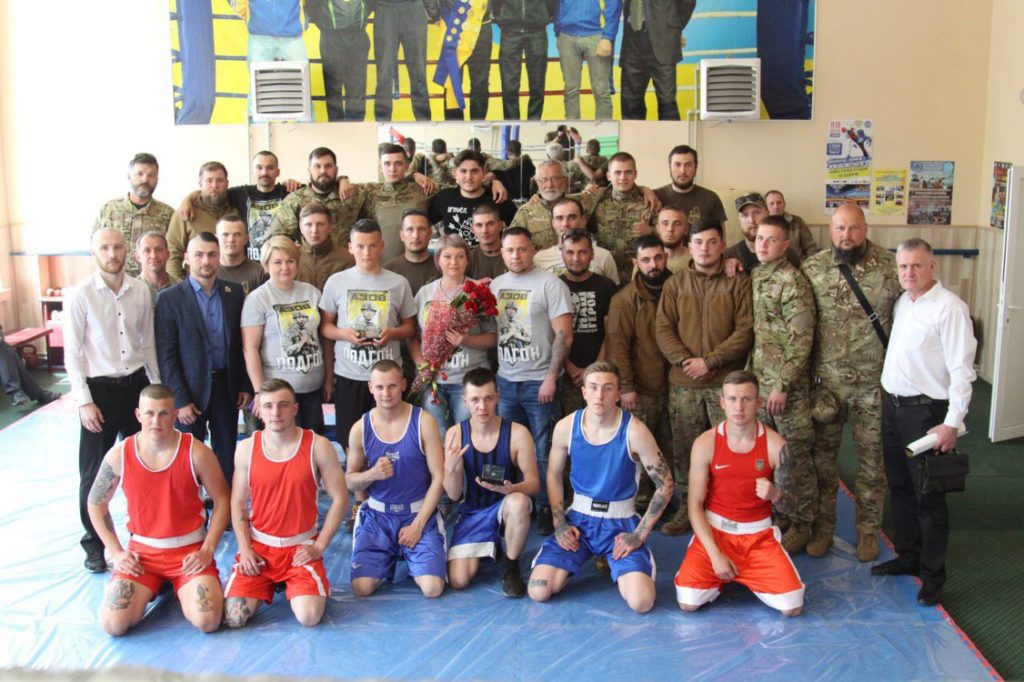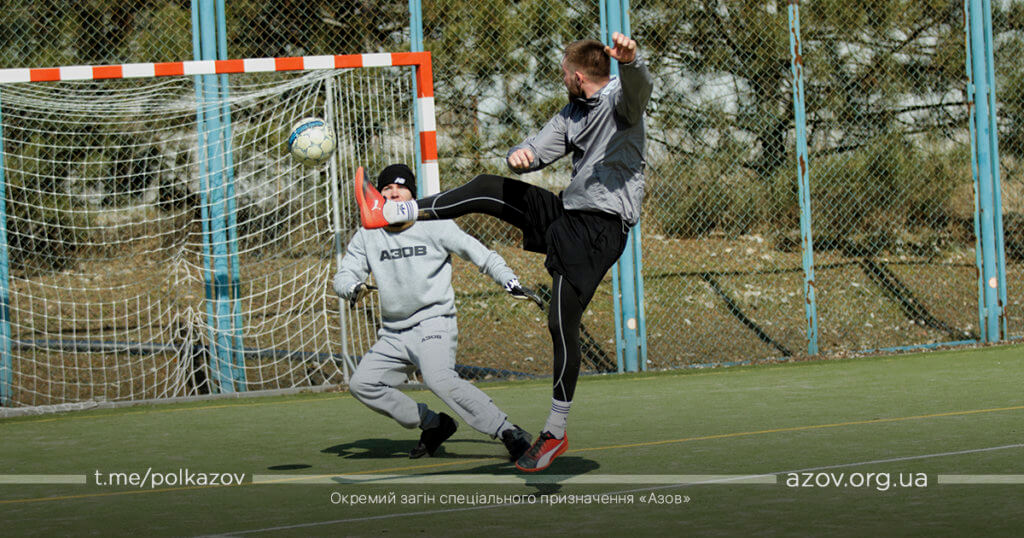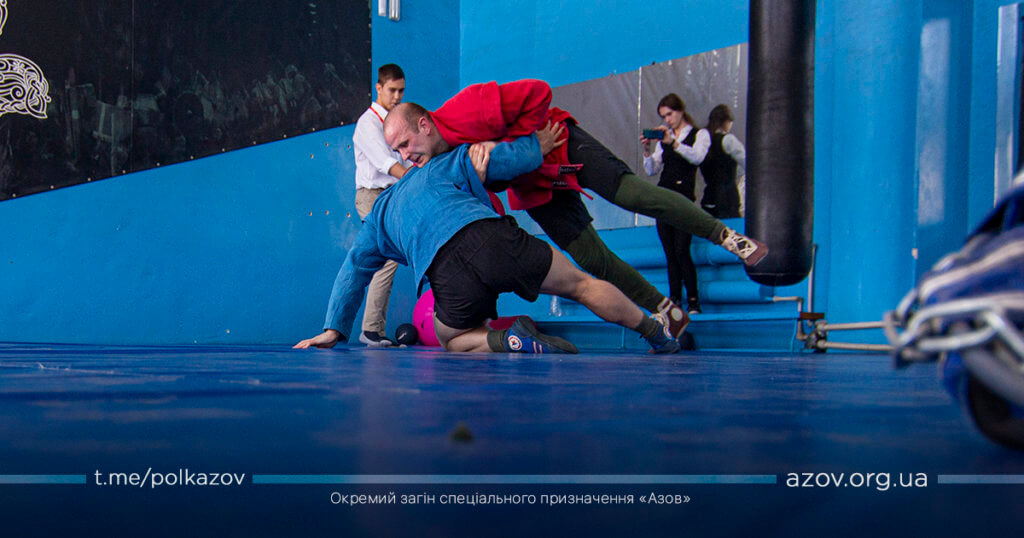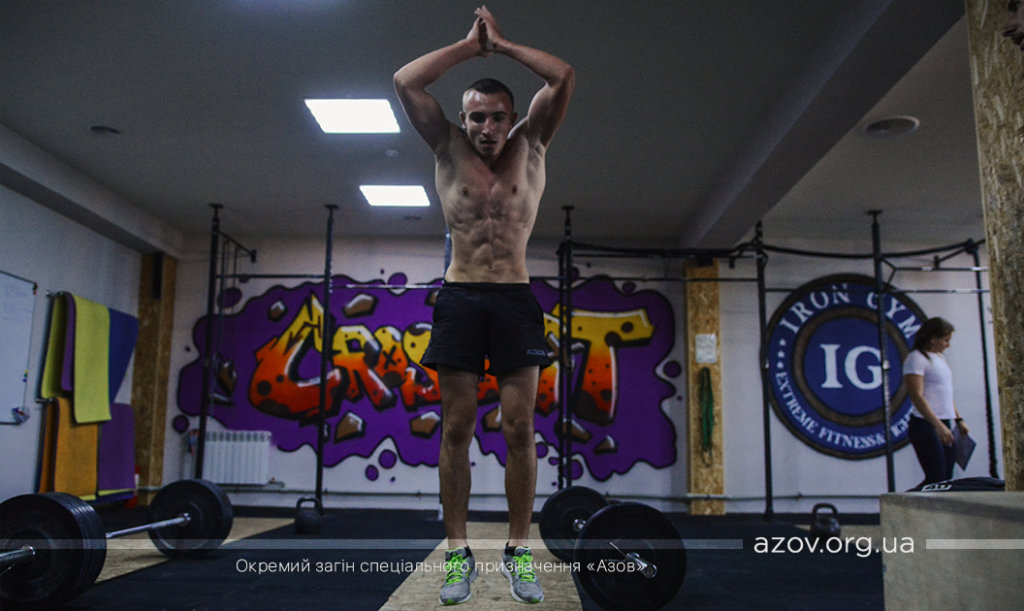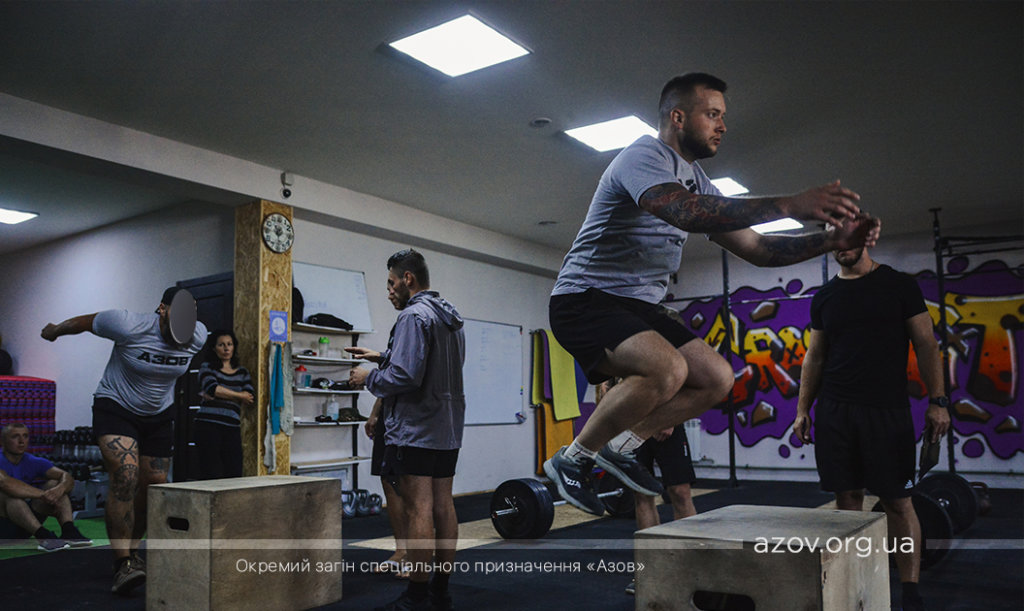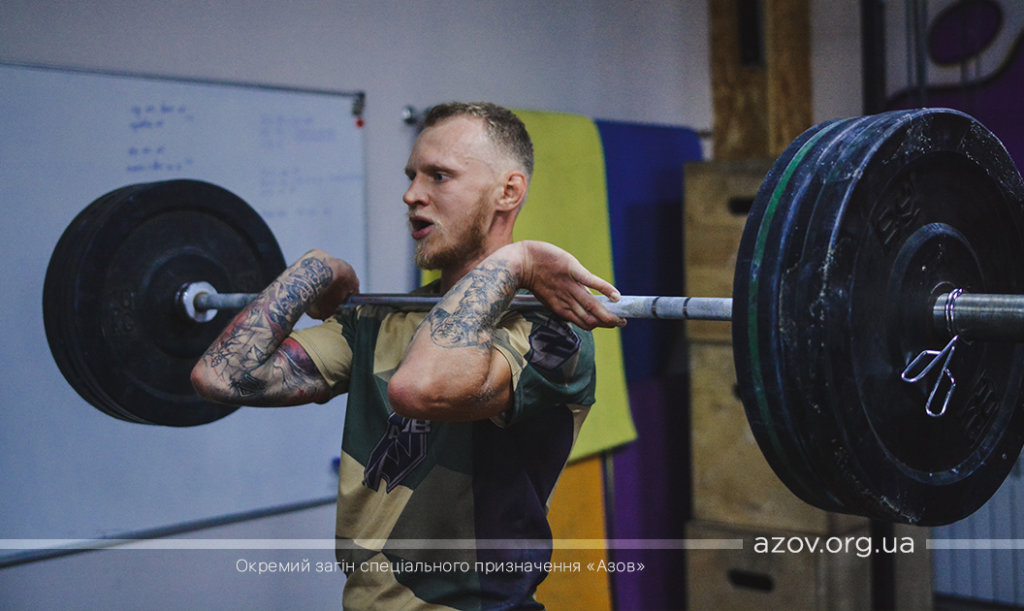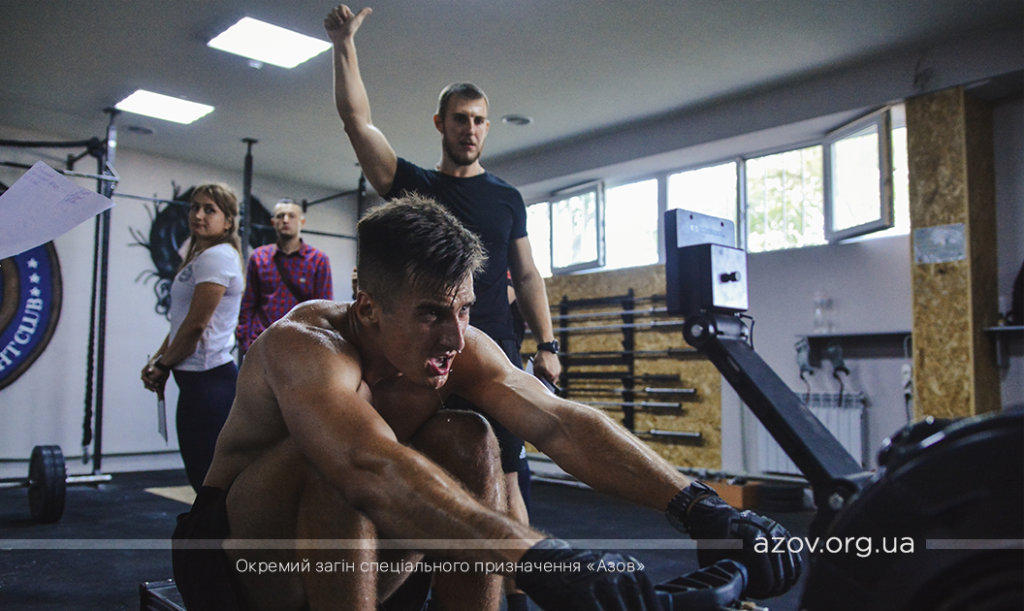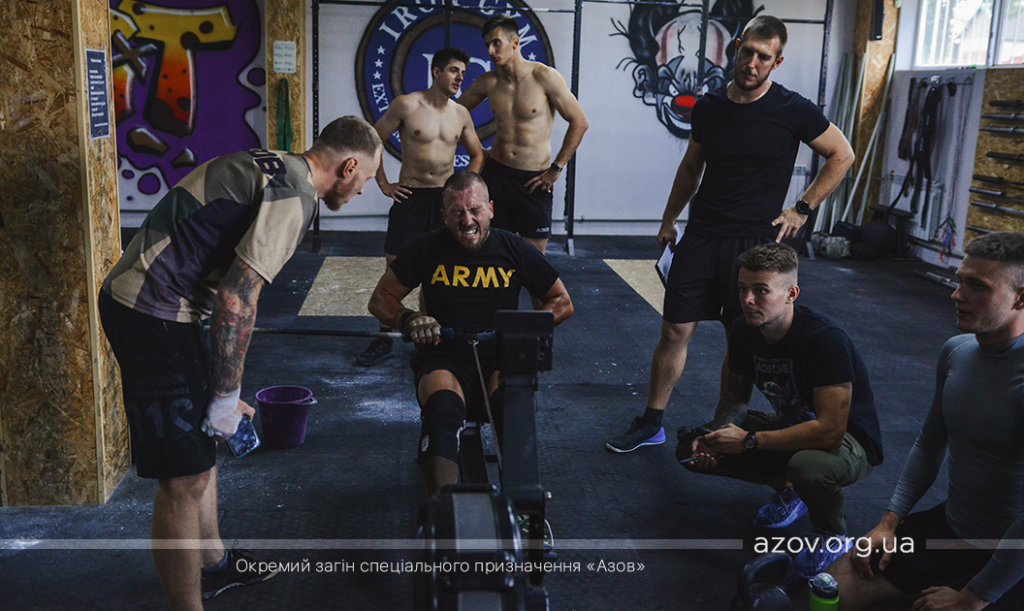Standard-bearer, or Khorunzhy service, and internal code of honor
Let’s go back to the beginning of our story, to the Hall of Fame. This wall of portraits of the fallen – a small detail at first glance, but one that speaks to the importance of the unit’s work with meaning. Everyone who comes to the Recruitment Center first passes these portraits, looks at the faces and names of the fallen.
This is the first contact with the realm of internal meanings within Azov. The initial signal that the unit doesn’t forget the possibility of loss, but at the same time that each fallen soldier is duly honored. This contrasts with the cultural background, with its cult of youth, beauty and health – here people don’t close their eyes to the existence of death. But most of all, it stands out against the backdrop of the rest of the Ukrainian military. It looks strange, but among the many criticisms of Azov, hardly anyone has noticed its peculiar cult of death. Perhaps it is only against the background of the realization of one’s own mortality that the true value of youth and its enthusiasm for life can be appreciated?
Since the phenomenon of Azov lies not at all in the cult of death but, to be frank, in the best moral-psychological work with personnel among all Ukrainian military. The best evidence of this is the defense of Mariupol for 86 days in the spring of 2022. Essentially, from the first days of being in complete encirclement, under constant fear of death — and not a single documented case of desertion, treason, or crossing over to the enemy.
Where does such unity, determination, and voluntarism come from?
American historian Edward Luttwak, characterizing modern strategy, defined contemporary wars as “post-heroic.” Indeed, in modern Western armies, there is no universal military conscription; all service has become contractual. Contact operations seek to minimize risk through technological advances, exemplified by the widespread use of unmanned aerial vehicles for tasks ranging from visual reconnaissance to firing at military targets.
Simultaneously, mass armies and volunteer associations are structures built upon non-materialistic values, united by an idea. Professionals in private military companies may not necessarily pursue only financial motives, but few units exhibit such strong solidarity as within the ranks of the Azov unit. However, even this requires work on an internal code of honor and constant soldier motivation.
Within the Azov Regiment, the Khorunzhy Service was introduced in 2015. Essentially, this was an unofficial initiative by individual fighters for officers, as part of their work with the personnel to address the spiritual needs of the soldiers.
Background: “khorunzhy” derives from Old Slavic “khorugva,” more commonly known as a gonfalon, which is a battle flag with images of sacred symbols. For military units, the flag embodies the honor of the detachment. During the times of the Hetmanate, among the regimental staff, there was a responsible representative of military administration called the regimental “khorunzhy”. The loss of the gonfalon meant disgrace and even the dissolution of the military unit. khorunzhys were selected from among strong and brave warriors capable of defending the battle flag in combat. In the 20th century, “khorunzhys” were present in all national military formations: the armies of the Ukrainian People’s Republic, Ukrainian Sich Riflemen, Ukrainian Galician Army, Ukrainian Insurgent Army. Notably, Olena Stepaniv was the “khorunzha” of the Legion of Ukrainian Sich Riflemen, the first woman in the world enlisted as an officer in military service.
The Azov “Khorunzhy” Service is a structure without analogs in other contemporary military units; its closest counterpart is the educating officer, well known to graduates of military lyceums. However, unlike the officer-educator, the “khorunzhy” is necessarily an individual from the ranks who serves alongside them. Among the duties of the “khorunzhy”, in addition to symbolically safeguarding the unit’s battle flag, is the organization of leisure for fighters: conducting lectures on history, military history, strategy, philosophy, cultural studies, organizing and conducting book presentations, thematic film screenings, sports events, and compiling recommended reading lists for personal development. This also involves the role of a mentor for comrades and ensuring support for maintaining the proper moral and psychological state by addressing and resolving their problems. Libraries were organized on the bases of the unit with the efforts of the “khorunzhy”.
In 2017, the “Khoryunzha” School named after Lieutenant Colonel Mykola Stsiborskyi was initiated to train regimental “khorunzhy”. The educational process aimed to standardize the work of “officer-khorunzhy” with personnel, including the teaching of military pedagogy, military psychology, military history, rhetoric, and national-patriotic education. At the initiative of the “Khoryunzha” School, books were also published, including “The Idea and Deed of Ukraine” by Dmytro Myron-Orlyk (killed by the Gestapo for resisting German occupation in 1942), memoirs of participants in the liberation operation of Mariupol, as well as memoirs of participants in the Pavlopil-Shyrokyne operation, and more.
Background: National-patriotic education of children and youth is a comprehensive, systematic, and purposeful activity of state authorities, educational institutions, public organizations, families, and other social institutions aimed at shaping in the younger generation a high patriotic consciousness, a sense of loyalty and love for the homeland, care for the well-being of their people, readiness to fulfill civic and constitutional duty to defend national interests, integrity, independence of Ukraine, and contribute to the formation of Ukraine as a legal, democratic, and social state. The most important priority of national-patriotic education is to form a person’s values towards the Ukrainian people, homeland, state, and nation.
— from the website of the Ministry of Education of Ukraine
The first “khorunzhy” to fall in Azov was Dmytro Pruhlo, with the call sign “Kruglyi”, who died on the front lines on the Svitlodarsk Bulge due to powerful shelling by 122mm field artillery from Russian positions. It is known that before serving in Azov, “Kruglyi” worked in the police. After joining Azov in the fall of 2014, the senior lieutenant participated in all subsequent combat operations of the unit. In 2017, he became one of the co-organizers of the “khorunzhy” service.

The need for “khorunzhy” service arose sharply after Azov was withdrawn from the front line in the summer of 2015. The volunteer unit, whose core consisted of people with no military education or prior experience in the Armed Forces, required internal work with personnel regarding discipline, basic education, and motivation. From the beginning, people of different ages, education levels, political beliefs, languages of communication, religions, nationalities, and professions coexisted in the unit. They were all united only by an irrational desire to defend Ukrainian statehood in a crisis for the country. Work still had to be done on everything else.
Another powerful factor in the consolidation of the unit was the evident political pressure and persecution of volunteer units that began after the signing of the Second Minsk Agreements. But Azov had a unique immunity compared to other volunteer battalions — it was officially part of the National Guard, within the structure of the Ministry of Internal Affairs. Although this did not save them from many issues related to the speed of providing weapons, access to military training, advanced technologies, and especially logistics. In the end, Azov learned to overcome these and other challenges independently.
Background: Minsk-2 or the Package of Measures for the Implementation of the Minsk Protocol is the negotiations of the “Normandy Four,” namely Ukraine, Russia, Germany, and France, on February 11-12, 2015, resulting in the signing of a protocol on the implementation of the Minsk agreements of September 19, 2014. The talks in the Belarusian capital concerned the implementation of previous agreements on a ceasefire, withdrawal of weapons, and holding elections in temporarily uncontrolled territories of Donetsk and Luhansk regions. In Ukraine, Minsk-2 faced criticism from the public and expert circles, especially for the necessity of practically amending the Constitution regarding the declaration of a special regime in the Russian-occupied territory of Ukraine, essentially federalizing the country. One of the conditions was the disarmament of illegal (volunteer) units, for pro-Russian controlled terrorists, this meant the formation from among the so-called “militia” — “people’s militia squads”, and Ukrainian volunteers were given an ultimatum to join the official defense structures.
In Azov, there were almost no people with previous combat experience, and later, this was reconsidered as an advantage. After all, in the unit, no one competed for ranks, did not seek favor with the command, and did not pursue positions. In Azov, they could only be earned.
So, the only value that united Azov fighters from the beginning was freedom. And the threat of it being taken away — external enemies and internal “traitors”. Meanwhile, the enthusiasm of the first months of the war had already passed, as well as the intensity of the fighting on the front lines and the tension in society. Azov was withdrawn from the front line with promises to return, which stretched until 2019. So, in the summer of 2015, a period of intensive growth begins.
In the same year, Azov introduced its own rituals and symbolism.
The unit’s badge – “Idea of the Nation”
August 11, 2015
On August 11, 2015, a new official badge for the unit was approved. It replaced the “popular” badge, which combined several symbols and had a connection to the local context: the sun rising from the Sea of Azov with the idea of the nation above them, and below — the state coat of arms. The new badge was a “dynamic,” “attacking” variation of one symbol, the idea of the nation itself, and a peculiar variation of the trident. According to the designers, the authors of the “reform”, the updated emblem of the unit symbolized development and forward movement.
The authors of the first unit badge were neo-pagans who intentionally depicted the symbol of the black sun. We can also mention the eponymous frontline magazine “Chorne Sontse” (Black Sun), which was printed in 2014-2015 by some volunteers of the unit. Many video materials dedicated to the early history of the unit contained the caption “pagan” … although this is undoubtedly an exaggeration and journalistic cliché, as “Azov” was founded by several groups, among which pagans were a minority (freedom of religion was always guaranteed in “Azov,” and representatives of different religions coexisted), but pagans were active and very noticeable. They self-organized and built wooden idols at several military bases. The leadership of the National Guard, commenting on this, did not deny the religious beliefs of Azov soldiers, considering their high effectiveness. The fighter with the callsign “Frost” commented on how Azov members became more religious during the defense of Mariupol and especially in captivity; in his cell, half of the prisoners were Christians, and the other half were pagans, some prayed near the right window, others near the left.
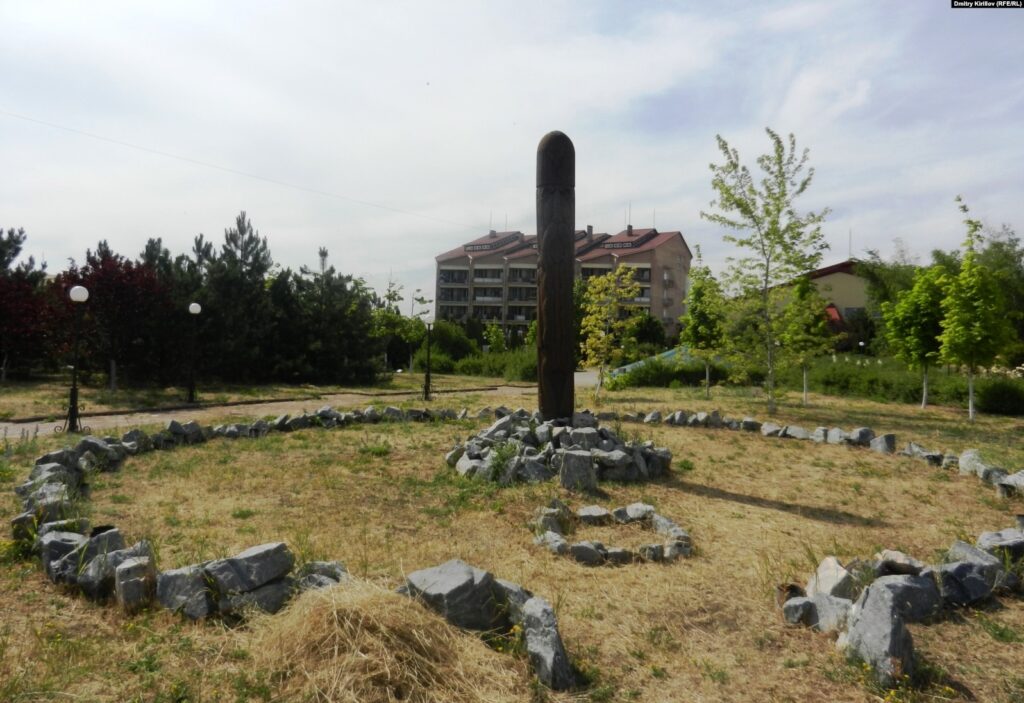
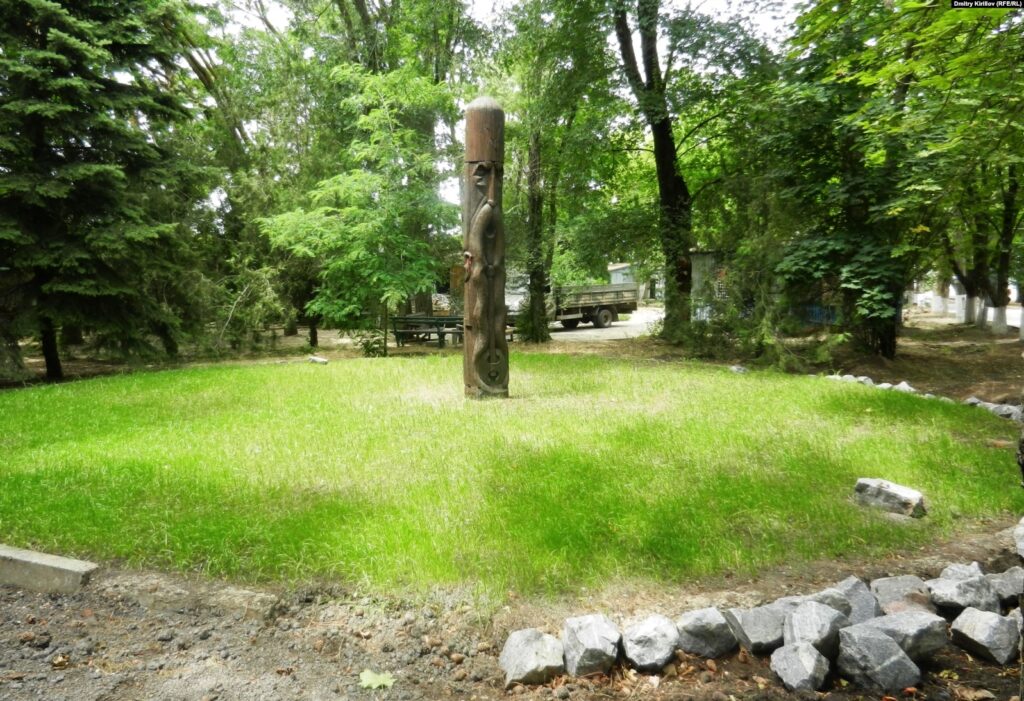
In contrast to conflicting testimonies, the “Idea of the Nation” has a long history for representatives of pro-Ukrainian forces and has been used since the 90s. Its author, Nestor Proniuk, considers the symbol already a part of modern Ukrainian folklore. The letter “N” was traditionally used in Old Ukrainian writing; it can be seen, for example, in the signature of Anna Yaroslavna, Queen of France. The symbol “Idea of the Nation” has an original history; during its creation, the author also relied on various “dynamic” variations of the trident.
The “Idea of the Nation” itself became a widely recognized symbol after the events of the defense of Azovstal in the spring of 2022. In the mass consciousness, it became synonymous with the bravery of Azov soldiers facing overwhelmingly superior enemy forces. The monogram also received its graphic textual embodiment — “ꑭ”. The Azov emblem also resembles a tilted crossed letter “Z”, literally symbolizing the fight against Russian troops, which inscribed this letter on their military equipment during the offensive in 2022.
As political scientist Ivan Gomza emphasizes, symbols evolve in their meaning, and modern recruits of Azov join the unit because of its combat glory, with the previous meanings of symbols essentially lost; now they are just attributes of successful resistance to Russian occupation.
Azov’s salute — a fist to the heart
As in many Western countries, and in the United States directly at the legislative level, in Ukraine, it is customary to place a hand over the heart during the national anthem. In the environment of politically active Ukrainian youth since the 90s, this tradition has been radicalized: instead of placing the hand over the heart, they use a fist. It signifies not only sincerity and honesty of intentions but also determination. Typically, the Azov salute is used during the anthem and paying respects. Later, military personnel and civilians alike began to use the fist to the heart, gradually making the gesture popular among the wider public.
Azov’s handshake — on the forearm
Another characteristic greeting gesture for “our own” is to shake forearms instead of hands. Since the time of the Roman Empire, especially during the era of chivalry, this gesture was used among the military to ensure that the person in front of you is unarmed, meaning they come in peace. In Azov, such a greeting is one of the small proofs that you are “one of us.”
The recitation of the Prayer of a Ukrainian Nationalist before the formation became an undisputed symbol within the military unit, revered on par with the national anthem of Ukraine. This ritual was introduced by one of the fighters in the Azov battalion, Mykola Kravchenko, who holds a Ph.D. in history. This tradition persisted in the unit even after his departure. According to historical records, the Prayer was authored by Osyp Maschak, one of the leaders of the Organization of Ukrainian Nationalists (OUN). The text was written in blood on the prison wall when the activist was sentenced for the assassination of the Soviet consul in Lviv in 1933, a symbolic act of revenge for the Holodomor in Ukraine. The Prayer of a Ukrainian Nationalist symbolizes the legacy and determination to fight against Russian neo-imperial ambitions, which became acute with the occupation of Crimea and parts of Donbas.
Note: In 2014, the process of decommunization began in Ukraine, officially legalized in 2015. It was essentially a practice to combat neocolonialism and Russian “soft power”, facing criticism and resistance from the Russian Federation, the successor of the USSR. Decommunization involved the removal of monuments to Soviet state figures, renaming streets after Ukrainian historical figures, and reinterpreting national history. As part of this process, Ukraine officially recognized the OUN-UPA as an important part of the national liberation struggle.
Mystery on the Memorial Day
Nowhere are the fallen soldiers treated with as much respect and reverence as in Azov. In addition to public memorial practices, the construction of memorials, and support for the families of the fallen, internal customs exist.
Every autumn, Azov conducts a special ceremony for fallen brothers-in-arms. On a chosen day after sunset, the unit gathers in full at an open location. Before the ceremony, usually on the field near the military base in Urzuf, near Mariupol, a symbolic reproduction of the Excalibur in the Stone monument, a Norwegian bronze monument erected in memory of a battle that led to the unification of Norway, takes place. The ceremony begins with the commander delivering a solemn speech about the unit’s military operations over the past year, victories, and losses. Then, the Prayer of a Ukrainian Nationalist is recited collectively. Subsequently, the “khorunzhy” takes the floor and begins to name the fallen warriors one by one. During this moment, the unit members hold wooden shields inscribed with the callsign of the deceased brothers-in-arms. When the relevant name is called, a fighter raises the shield above and declares, “We remember!” The formation responds, “We will avenge!” This symbolic act refers to the custom in ancient Sparta when a fallen warrior was carried from the battlefield on a shield and the well-known phrase “with a shield or on a shield”. Thus, each fighter takes responsibility not only for their own life and the life of those standing shoulder-to-shoulder but also for continuing the cause of those who have already fallen in battle. Each battle pursues a higher purpose than just following orders, and this approach allows everyone to consider themselves co-participants and co-creators of victory.
In 2022, after the start of the full-scale invasion, the official term for fallen Ukrainian soldiers changed from the Soviet-era designation “Cargo 200” to “On the Shield”. Spartan customs gained popularity among Ukrainians, possibly influenced by the example of Azov’s rituals for honoring their fallen.
Mariupol — the city of Azov’s glory
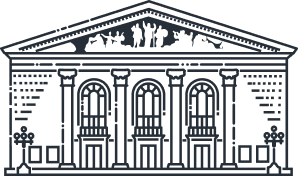
Founded in the city of Mariupol, on May 5, the Azov Battalion, consisting of several hundred volunteers, became a nightmare for Russian media for many years to come. Ultimately, Mariupol remained a coveted place for the Russians since 2014, being a key city on the route to establish a land corridor to the occupied Crimea. It is also the second-largest city in the Donetsk region, an industrial and economic center where many refugees relocated, escaping the terrorist rule of self-proclaimed republics, and, equally importantly, the largest port in the Azov Sea. At the same time, it was a crucial location for Putin’s declared “denazification” due to the constant presence of the Azov Battalion. In 2014, pro-Russian forces made two attempts to capture the city: in the spring and at the end of summer. If the first attempt counted on the domino effect and destabilization of the political situation in Mariupol, following the examples of Donetsk and Luhansk, the second time, tank columns from the Russian border were used as an “argument”. In both instances, Ukrainian defense forces, led by Azov, fought back and pushed the enemy away from the city.
In honor of Mariupol’s liberation from pro-Russian terrorists, a state holiday was established in 2016 – Mariupol Liberation Day, celebrated annually on June 13. The festivities began with a march involving Azov fighters, the command spoke to the peaceful residents of the city, and the military equipment of the unit was showcased. The liberation of Mariupol by Azov and other units became the most significant military achievement of the summer campaign in 2014. The Ukrainian Institute of National Memory notes that the liberation of Mariupol was a turning point in the Russian-Ukrainian war, preventing further occupation of Ukraine.
Another significant day annually celebrated in Mariupol is the founding day of Azov. So, on May 5, the residents of Mariupol had the opportunity to interact with their defenders during ceremonies organized by the home front service.
Intercession of the Theotokos – a holiday of Ukrainian arms
October 14 was a holiday unofficially celebrated in Ukraine since the early 2000s. This day coincided with the important Christian holiday of the Protection of Our Most Holy Lady Theotokos and Ever-Virgin Mary. During the times of the Zaporizhian Host, there was a cult of Intercession, and some researchers, like the historian Dmytro Yavornytsky, believe that this cult was dominant. There was also an Intercession church on the Sich. Therefore, Intercession was one of the main holidays of the year. On this day, Cossacks arrived at the Sich, and if necessary, a council was convened to change the leaders (Cossacks had a military democracy), and rituals and ceremonies were held. In a sign of continuity of Cossack traditions, the day of the founding of the Ukrainian Insurgent Army (UPA) in 1944 was proclaimed Intercession Day. This day became highly respected among the Ukrainian diaspora abroad after the UPA was defeated by the Soviets, and especially after the “Parade of Sovereignties” among Ukrainian patriotic forces.
The struggle for the recognition of the contribution of Ukrainian national liberation movements of the 20th century to gaining independence became one of the political demands of pro-Ukrainian forces and a factor in political self-identification. Therefore, it is natural that October 14 became a “sacred” date for Azov — not only as the formal Defender of Ukraine Day but also as a symbolic “legacy” from pro-Ukrainian activists who founded the unit.
Azov Sich
“…here gathered true military daredevils in the best Cossack traditions. They are ready to fight the enemy anytime, anywhere, and do it with pleasure and courage. We are building a modern army that should be a reliable defense of the country and the nation, demonstrating high indicators of combat effectiveness, which has been repeatedly noted by military leadership”, wrote “Bilotur” in his autobiography, the artillery commander killed in the Olenivka terrorist attack.
In Azov, Cossack traditions of military democracy are especially honored and followed. The Cossack era is usually associated with a combination of adventurism, audacity, and discipline. The hetman was chosen as a person burdened with the authority of command rather than gifted with it. The most important decisions were made at military councils, but despite such joint decision-making, there was iron discipline in the army. Cossacks were equal and equally subject to the law. According to Cossack traditions, Azov is an open community that accepts only if a recruit is willing to share the values and traditions of combat brotherhood. There was a tradition of mentorship, where older, experienced warriors, Cossacks, taught younger ones, helping not only to pass on military knowledge but also to instill traditions and form an understanding of brotherhood as a family, where the elder Cossack was like a father. In Azov, there are self-government and internal military ranks and historical names of tactical units used during the Cossack era and the liberation struggles of the 20th century. Instead of a platoon, there is a hundred, a squad — a chota, as well as ensigns, centurions, chotovi, royovi, and so on. In their free time from battles, Cossacks paid a lot of attention to education, to be ready to go on a military campaign at any time. Ultimately, in Azov, formal statuses, regalia, and wealth are of little interest to anyone because combat glory and service to comrades are more important in the unit. Therefore, Azov attracts those who appreciate the phenomenon of Cossack chivalry.
Azov Agon
Practically every holiday or memorial day in “Azov” was accompanied by the organization of sports competitions or tournaments. In particular, this was how the annual memorial service for the fallen took place. This Cossack and knightly tradition symbolizes the immortality of the spirit, practiced since the times of Kyivan Rus. Agon (from Greek – “competition”) is a striving for constant measurement of strength, this competitive spirit, pursuing the goal of constantly testing one’s physical strength and striving for perfection. Unlike modern sports with a quantitative approach, the competitive approach aims to achieve constant ideal form and its constant affirmation. Every quarter, Azov soldiers undergo physical training. Agon does not imply a victory once and for all, so one must constantly keep oneself in shape. The stimulus is to be the first among equals. Therefore, perfection requires the development of not only physical but also moral qualities — endurance, moral stability, perseverance. The combat successes of Azov can be easily explained by the spirit of constant competition within the unit.
The phenomenon of “Azov” lies in the fact that the unit managed to preserve its vitality and ideological motivation of each soldier, which were characteristic at the point of highest social tension — and at the same time, for several years, to raise military professionals, guided by high standards. “Azov” is an example of how the fighting spirit transformed into a military ethos.
